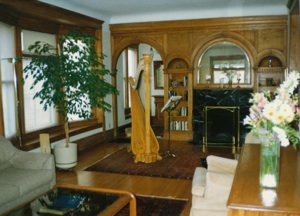
Anecdotal Vita
I was born in 1949 in Yakima, Washington and grew up in Selah, a town of about 3000 people not far away from there. You can read about my family and my early childhood in the McLerran section of this webpage.
Selah was a wonderful place to be a kid. I could ride my bike anywhere. My parents were not worried about such independence, being more worried by visions of Communists from Russia or China than of predatory child molesters. Every kid who was old enough to walk went door to door for Halloween, and all the candy got eaten.
I had favorite fishing spots, and hikes and long bicycle rides took me to them. I was never too picky about the kind of fish I caught; I was happiest simply with catching a lot of them.
I had my first job when I was 14 years old. I picked corn, following a truck through fields in hundred- degree heat. I acquired a rich vocabulary from older workers which in times of stress naturally comes back to me. I worked every summer on the farms in a variety of roles, and by the time I was in college was probably the fastest apple picker in the orchards where I worked. I could make around 50 dollars a day.
I still remember a coyote which would come to a pile of wood I used for propping trees where I worked in one of the orchards. He wanted to get close and make friends, but every time he started to move forward toward me he thought about it and pulled back. I also met an old man who was incapable of telling a lie, and it got me thinking hard about honesty. In the end I concluded that lying was probably not such a good thing for most people, since you have to remember all your lies, and if you are caught out once, you are finished (unless you are a politician).
I went to school in Selah until my junior year in high school. I was a good student but not an outstanding one. The young people I went to school with in Selah have as the years pass become more and more interesting to me. I was recently at the 40 year anniversary of Selah High School, and received a CD showing photos of the classmates as young people. I can now see in those images things that I did not think about or appreciate at the time. In almost all of the photos, you can sense drive, energy and optimism. There is an eagerness to take on the world, an impatience with being young, and a body posture of challenge.
I think this was a very good time in history, and Selah was good for the kids growing up there. There was a strong sense that the world would be a better place, that we would do better than our parents, and that our children would do better yet.
There was of course tension. The Cuban missile crisis came and went. Many of my friends’ families had fallout shelters dug into their backyards, and we boys would use them as a place to read our favorite magazines. There were above-ground nuclear tests in those days, and 50 miles away at the Hanford Atomic Works they were carelessly venting radioactive gas and doing a poor job of storing radioactive waste. Yet these things did not seem close to our lives.
Of course, the Vietnam War came in my last years of high school, and this war I think greatly changed the psychology of America. Optimism changed to cynicism, and pride to anger and then to shame -- both over what we did in Vietnam and what we did to our young people who had served there. A lot of time has passed now, and many of the scars of that era have faded. But the war damn near destroyed some of my best friends. Somehow they managed to pull themselves back together again and raise good families and kids of which they are very proud. My friends were lucky. Not all those damaged by the war made their way back with such success.
I now have a good friend, Dam Son, who is from Hanoi in Vietnam. We first met in Moscow about 15 years ago. We were sharing an office, and at first we both hesitated to talk with one another about the war. After talking a little bit of physics with me, Dam asked me what I thought about the Vietnam War. I told him I was not too happy about what we did there, but I was much less happy with his country. I can read some Russian, and had read a propaganda novel supposedly written by a North Vietnamese soldier. I was sickened by the bragging about how they murdered the families of teachers and doctors in towns that they had “liberated” simply because of their “class”. Dam and I talked for a little while, and then he simply told me that when he was a baby, the bombing had ended. I understood that much time had passed, and he was younger than I.
Selah was a town of farmers, many of whom had immigrated to the Yakima Valley during the Dust Bowl. Those who were not from Arkansas or Oklahoma or Missouri also had struggled through the Great Depression, largely by the sweat on their backs. People were proud of what they had accomplished, and had little tolerance for those who didn’t make it.
In my junior year, I moved to Richland, where I graduated from High School. Richland is an unusual town. The Hanford Atomic Works, nearby, was one of the places where work was done on the atomic bomb during the Second World War. The town was built for the workers, managers, engineers and scientists who built the chemical separations facilities essential for the atomic bomb project during the war. Richland was a secret city for a period during and immediately after the war. The high school team name is The Bombers. The young people there were largely the children of upper-middle-class college graduates. Most parents had carefully planned out their children’s futures.
I graduated from Richland High School in 1967, and was accepted for college at the University of Washington in Seattle.
Childhood and Early Education
Undergraduate and Graduate Education
I was the first of my family to go to college, and had no idea what to expect. Although the university I had chosen was in Seattle, just on the other side of the Cascade Mountains, for me it was a new world. The west side of the mountains, where Seattle is located, has a history and traditions that differ from those of the east side. The greater Seattle area dwarfs Yakima in size and population. The people who live there have largely recently moved from other parts of the country or the world. There is a large Asian population, many of whom have deeper roots in the Northwest than the average inhabitant of European background. The geography is different, and it often rains on the west side of the Cascades, but rain seldom gets across the mountains on the east side.
Many of the folks living west of the mountains have little respect or appreciation of the values of the people from eastern Washington, sentiments often mirrored by the estimate of those to the east of people on the Seattle side. Those to the west see the population of eastern Washington as ignorant, uneducated rednecks. Rednecks is an expression which comes from the burn one gets laboring in the hot sun, and some intellectuals consider such labor demeaning; and the word redneck is used as an insult. Many east of the mountains, on the other hand, view those choosing to live on the other side of the mountains as apt to be lazy and “entitled” -- expecting the Government to compensate for failure. The cultures, values and histories of these people are almost as different as those of France and the United States.
At the University, I found myself for the first time surrounded by people who had real interest in books and learning. I remember during my freshman year how I got the two-volume Penguin edition of War and Peace, and read it in a few nights, staying up late until three or four in the morning. This is still my favorite book and I have read it many times, both in Russian and in English, astounded by Tolstoy’s ability to portray characters in a manner so three-dimensional that I have been able to view them from different perspectives at different times in my life.
I found that to understand my classes I had to read and think hard about what was said, and then to learn to work with the ideas. The process required discipline. I had come with little of that, and had to acquire it. All this was all new to me. As had been the case in high school, as an undergraduate I was a good but not outstanding student.
I began as a pre-medical student with a major in chemistry. I rapidly discovered that this goal was not for me. Chemistry and the pre-medical curriculum required memorization, and I was never good at that. I liked to take apart what I learned and recombine it with other ways of thinking and try to rearrange the ideas before recombining them. Chemistry is to me was what Scientific Communism was to my Russian colleagues: Both are fields where it could be dangerous to reinterpret in a creative manner.
I soon found that physics was suited to my taste. I began taking physics in my sophomore year, and to complete a major in this field was difficult because a degree really required four years of study. At that time, the Vietnam War was in full swing, and I knew I would be drafted if I stayed a fourth year. In any case, I could not afford to be a student more than four years. It was too expensive. I decided I would take my Freshman and Sophomore level courses in physics during the same year. This was possible, but it required a lot of work.
There was much going on outside of my classrooms. There were many protests against the Vietnam War. I rode on a bus full of radicals and hippies to San Francisco to go on a huge peace march. I was involved with the Student Mobilization Committee to End the War in Vietnam, and Draft Resistance Seattle. I remember one woman who was a leader in the Students for a Democratic Society who loved to yell into a megaphone. Twenty five years later I was on the University of Washington campus, and the very same woman was still yelling into a megaphone. Holy Hubert who came up from San Francisco to teach heathen students about God, was already a well-known campus personality when I was an undergraduate. He had two friends who ran a fundamentalist congregation; they walked around preaching wearing gunny sacks. One night the two friends had an argument, and one of them shot and killed the other.
There was the Red Robin Tavern, which was down below the ship canal bridge. This was a place where members of the far left Students for a Democratic Society would some times hang out. I think they liked the name, and the atmosphere was suitably proletarian. It was bought some years later by a group of investors who have opened up a chain of the same name. There is still a Red Robin in Seattle, near the site of the original tavern.
We had campus politics as well. Tom Gunn ran and won the presidency of the UW student body. He won because there was a stripper who had recently won the presidency of the Stanford student body and she came up and gave a “speech” for him. She gave an inspiring speech. The next year, a dog ran and came in second.
I somehow survived the rather arduous curriculum I had set up for myself. I think I probably would have finished with my bachelor’s degree and gone of to get a job were it not for some beautiful lectures on mathematical physics given by Lowell Brown during my senior year. Lowell has a way of making ideas very elegant, and I admired his crisp and precise way of thinking. I decided to apply to graduate school, but only at the University of Washington, as for personal reasons I could not leave the Seattle area. I received a teaching assistantship that gave me a small stipend and paid my tuition.
I remember my first year courses very well. Homework problems would sometimes take me days to finish. I learned that really solving hard problems means allowing them to possess your mind day and night. Often in the middle of the night, or when you are riding a bike in to the University, you discover a new way to think, and it is a good feeling. Much later, I learned that I think in unusual ways, and what had given me trouble as a high school student or an undergraduate had some advantage as a theoretical physicist. Such thinking is good for generating new ideas, but perhaps not ideal for solving homework problems and taking tests.
I started doing research towards the end of my first year, Ken Johnson was visiting the University of Washington from MIT. I asked him if I could learn quantum field theory from him, and he agreed. Ken was a very good teacher. He started simply by suggesting some books to read. Every week or so, I would come and ask him some questions about what I had read. He gently led me to more advanced texts, and in a few months I understood most of the basic ideas.
By the beginning of the second year I was actively doing research. I started with Marshall Baker on problems related to high energy scattering. Marshall is a very kind and gentle person. He helped me to think creatively and taught me that carefully crafting a concept can often be more powerful than using elaborately developed mathematics to extend these concepts.
When Marshall went on sabbatical, I started working with Lowell Brown on what became my thesis. The thesis project is described in the Physics section of the webpage. Lowell is a strong calculator, and once an idea is clearly spelled out will develop it with great skill, elegance and accuracy. Lowell taught me that using elaborate mathematics to clarify half-thought ideas is often more powerful than a creative but incompletely developed thought. I finished the work for my thesis project by the end of my third year, and then returned to work with Marshall on high energy scattering.
In my last year in graduate school, I applied for postdoctoral positions. Lowell and Marshall wrote very strong letters of recommendation, and I got offers from MIT, Princeton, Stanford and Cal Tech. I accepted the offer at MIT. I was able to fly around the country for the first time in my life when I gave talks as part of the interview for jobs. (I lost all of my socks and underwear on this trip, and with a graduate student stipend, that is a big loss.) The talk I offered was prepared following the strong advice of Lowell and Bob Cahn that a good talk should have slides with mainly illustrations, and only about one equation per slide. I still use that advice on young people. Keeping equations to a minimum and graphics to a maximum forces you to explain ideas rather than present the details.
I received my Bachelor’s degree in 1971 and my PhD in 1975 from the University of Washington in Seattle.
Postdoctoral Fellowship at MIT: 1975-1978
Boston is a tough place for anyone who had never been outside of the Northwest. I was asked for the first time in my life “Where are you from?” I honestly did not know what was being asked, since the question was repeated after I said Seattle in a confused voice. After a while I figured out they wanted to know which country my ancestors on my fathers side had been from before coming to America. I knew the answer was Scotland, but it was a strange question because those ancestors had arrived in the US in the 1700’s, and had intermarried across ethnic and racial divides.
MIT was a tough place for me too. The postdoctoral fellows and students are on one floor and the faculty on the floor below them in the Center for Theoretical Physics, and this reflects the separation of physicists of various levels of experience into something akin to classes, a formality with which I had no prior experience. Moreover, as a graduate student at the University of Washington, I would have only one or two young people with whom to discuss physics, and I was rarely challenged. At MIT, there was constant challenge by students, postdocs and faculty. They did not suffer fools gladly, and I was afraid that I might be a simple fool. There were good reasons for their behavior and my insecurity. At graduate schools like Harvard or MIT, there is a much more demanding curriculum and a wider range of courses. Students there are tested all the time in conversation, seminar and exam. I simply had not developed the knowledge nor the rhetorical skills to deal with the talented people who surrounded me. I had to spend much of my time learning new ideas, because I in fact did not understand many of the issues discussed. I probably missed some of what MIT offered by needing to fill in the blanks that my earlier preparation had allowed. I now try to always build an environment of challenge among young people with whom I have responsibility. It is the methodology of science.
I did learn many new ideas, and developed some of my own while at MIT. Ken Johnson, who had mentored me at Seattle, suggested that I think about quarks at very high density. This was a good project for me since it used my computational skills, and while doing the computations, gave me the time I needed to learn some of the many new ideas I was hearing. The work on Quark Matter is described in the Physics section.
About a half a year after arriving at MIT, I met Alice and we were married a few months later. We had a number of young friends among the students, faculty and staff at MIT. We would often go out to the F and T Diner in Kendall Square for beer and fries on Friday night. We would recite the universal litany of young scientists everywhere, one that involves themes like: Why does he have a job and I don’t? Wouldn’t it be good for the job market if there was a big scientific meeting and all the full professors were on one plane, , , , There were “Many Tears in the Beers.” One of Alice’s favorite Tom Swifties came from the wall above the toilet of the F and T: “‘I am neither a homosexual nor a necrophiliac,’ said Tom in dead Ernest.”
One of my best friends was Charles Thorn. We introduced him to Alice’s best friend, Mary Furman.
They fell in love, and now are living happily ever after in Gainesville, Florida. My collaborator, Barry Freedman, was an incredibly hard-working and delightful young man. He later developed a numerical algorithm for solving the traveling salesman problem: How to minimize the connection times between various cities during a round trip. He became deputy director of operations for Northwest Airlines. I also worked with Roscoe Giles, a totally off-scale theoretical physicist from Stanford who was gifted both in human relations and in his intuitive feel for physics. Sometimes you meet “naturals” who effortlessly and quietly soar. Roscoe was the first such person I had met.
Myron Pauli was another student at MIT then. Myron was the grand-nephew of the very famous theoretical physicist Wolfgang Pauli, and now works for the Naval Research Labs. Myron was at that time a perfect portrait of a mad scientist. He wrote songs about the faculty at MIT sung to the lyrics of well known, or at that time popular, music. For Ken Johnson (who had invented the MIT Bag Model), to the tune of Old MacDonald’s Farm:
Old Ken Johnson had a bag. E I E IO. . . .
With a quark quark here, a quark quark there
Here a quark, there a quark
Everywhere a quark quark, , ,
For John Negele (who wrote big computer codes) to the tune of “Charley on the MTA” (a song about how Charley was condemned to ride the subway forever because of a fare increase he could not afford to pay to exit):
No it never converged
No it never converged
And its fate is still unknown
It runs forever ‘neath the streets of Boston
It’s the program that never converged
These were times when I learned much about science and perhaps even more about people. The atmosphere was indeed tough at MIT, but it worked well enough for me, and it got me involved in a set of problems that has been the central focus of my career in theoretical physics. I think one cannot ask for more.
I stayed three years at MIT, and accepted a postdoctoral fellowship in 1980 at the Stanford Linear Accelerator Center.
Postdoctoral Fellowship at Stanford Linear Accelerator Center 1978-1980
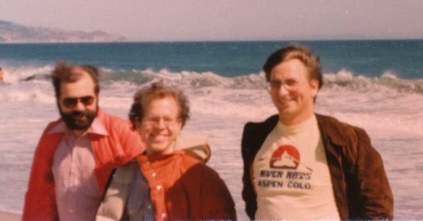
Me, Mike Dine, and Christof Litwin near Pescadero Beach
Alice and I sold our house in Brookline, packed up our four cats, and flew out to San Francisco. The cost of housing is perpetually high in the Bay Area, but we found a house we could afford to rent, on a secluded flag lot near downtown Menlo Park. Our neighbors to the back were the priests of the Russian Orthodox Church there, who raised bees. The bees were remarkably gentle and clever; we could walk barefoot on the lawn as they browsed for nectar in the clover without risking a sting. We enjoyed the music that drifted from the church on Sundays. I could ride my bike to the lab in about 1/2 an hour. We bought our first car, a 1978 Toyota Celica.
The atmosphere at SLAC is egalitarian. This is typical of national laboratories, where the salary structure is more uniform than at universities. Seminars would often last well past the canonical one hour. My office was a shared one, unlike MIT where I had a private office. My first year office mate was Pierre Sikiivie. Pierre Sikivie, Mike Dine, Eddie Farhi, and Christof Litwin all became my good friends during that time.
I would often go surf casting along the beaches on the Pacific Ocean south of Half Moon Bay. On some occasions I would go with Mike Dine and Christof Litwin. We would wade out to the big rock at the south end of Pesdadero Beach, and often would barely make it back before the tide was so high that wading was impossible. There were many crabs and mussels on these rocks. Once Christof had brought his new camera along and laid it on the rocks. The crabs came along and dragged it off into a tide pool. We caught many sea perch, an occasional cabezon, and very rarely a sea trout. Our bait was pile worms about which we would later joke in the comfort of my home, while listening to Dr. Demento on the radio.
We would have dinner parties at our house. We also had Sunday brunches at which guests played croquet in the yard, which Alice had discovered the theorists did with totally shameless aggression. One time Lenny Susskind came over with a bottle of champagne with a plastic cork. He opened it over the sink, the plastic cork came flying out and broke the kitchen window.
We had a cat Amanda who had taught herself to do something that amazed us. We discovered that she had learned how to use the toilet although not how to flush it. At one dinner party she saw all the people sitting down to dinner and decided she could generalize this trick. She jumped up on one of the chairs, shat on it, and looked up expecting to be praised. I praised her because she showed great intelligence and initiative (although little refinement).
Lenny Susskind had Thursday night pizza meetings at his house. I remember that Eddie Teller, the father of the hydrogen bomb, was visiting the Hoover Institute at Stanford, and he would sometimes attend. Teller was old, but very sharp. He would ask questions in a slow deep voice, and look very forbidding with his big bushy eyebrows. Among physicists, Teller is quite controversial, both for his efforts on national defense, and the bitter fight he had with Oppenheimer. His national defense efforts seem to involve scenarios from science fiction, sketched without attention to detail. I understand him better from having seen his enthusiastic imagination, clearly on display at these meetings.
At times, Sid Drell, the head of the SLAC theory group and a scientist with a distinguished record of public service, would occasionally have a party at his house on campus. Sid has been very much involved in arms control, and advising the government on scientific policy. Alice liked to talk with Sid very much since they had many interests, political and social, in common.
At the end of my first year, I went on my first trip to a meeting outside the US. This was the International Cosmic Ray Meeting held in Kyoto, where I was to present work I had done with James Bjorken on Centauro events. This work and the collaboration is described in the section Physics. I was amazed by Japan. I had to get used to cars driving on the wrong side of the street. Beer machines were the highest form of civilization I could imagine, especially on a Kyoto August day. At night, I would retreat to my hotel, put on my robe, and sip hot sake I bought from the sake machine. I was surprised by the different sounds of the language and the way language reflected the strong separation in roles of men and women.
The second year at SLAC I shared an office with Gao Chong Shou, who was among the first delegation of Chinese scientists to visit the US after the end of the Cultural Revolution. Gao was part of a delegation with Tao Huang and Bing an Li. Alice and I become friends with them, and remember very fondly a dinner they hosted for us at the apartment they shared.
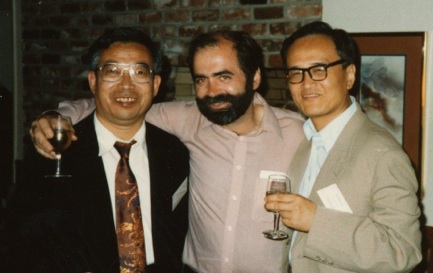
The photo on the right shows Gao Chong Shou on the left and Huang Tao on the right. Gao was a professor at Peking University, where he has become a distinguished senior faculty member, and Huang Tao later became head of the theoretical physics group at the Institute for High Energy Physics in Bejing. When I met them, they were struggling to learn English, and to catch up with 20 years of physics which had been lost to them as a result of the Cultural Revolution. They were in SLAC for the entire year.
Gao Chong Shou, me and Huang Tao in 1986
About the end of the time I was staying at SLAC, there was a party, and while riding down Sand Hill Road, Gao flipped over on his bike. He was found beside the road, and taken to the emergency room of Stanford Hospital. After a day or so, his brain began to swell, and they had to remove a piece of bone at the top of his head. He was in great pain for a month, and remembers little of it. Sid Drell arranged the best doctors at Stanford to care for him, and managed their payment in spite of the fact that there was insufficient insurance. More remarkably, Sid convinced the Chinese that they should allow his wife to fly over to the US to help care for him. Gao was very lucky and had excellent care. I remember that months later when he flew back to China, he was flying through Seattle where I then was on the faculty of the University of Washington. Sid called and asked me to go to the airport to make sure everything went smoothly during the transit. Gao was in good spirits, but still in a wheel chair. Now, his only scar from this trauma is that he walks with a limp. He continues as an active theoretical physicist.
I carried out several scientific projects described in the section on physics. These concern the nature of matter at very high energy density, with Ben Svetitsky, and the production of such high energy density matter in heavy ion collisions, done with Peter Koehler and Ramesh Anishetty.
I remember the times at SLAC very affectionately. Sid was always justly proud of the atmosphere there. I learned that people who are kept so busy that they think they can get nothing done often accomplish much. I always look back at SLAC as the most productive time in my career, but I also do not remember where I had the time to do any of it. I think during the last few years at Brookhaven National Laboratory, I may have matched my productivity as a young man at SLAC, but if so, it is only because I applied the lessons I learned there to the group at BNL.
In 1980, I received offers of assistant professorships from the University of Washington in Seattle and the University of Minnesota, and accepted the position at Seattle.
Assistant and Associate Professorship at University of Washington: 1980-1984
Returning to the University of Washington as a faculty member seemed at the time like a good thing to do. Alice and I both love the Seattle area, and I have good friends and family there. We bought a beautiful old house in the University District and began rehabbing it. There was a lot to do. The house had been rented to many generations of students who had no interest in maintenance. The last ones had started to remove woodwork to chop it in front of the fireplace to use as firewood; they hadn’t paid the gas bill. We gradually brought the house and garden back to respectability, and a rug covered the axe scars in the hardwood floor near the fireplace. We enjoyed remodeling the bathroom, an unusually spacious one with a clawfoot tub (which we moved from the center of the room to a place near one wall) and a handsome pedestal basin (which we moved to a spot where the morning sun’s rays would not be reflected straight in the eye as one tried to brush ones teeth). And we transformed the small apartment in the basement from a rather grubby space to a truly livable one that could be offered at an affordable rent to tenants who loved cats and would be happy to care for ours when we traveled; it was a very convenient system.
Much of what Alice did during this period is described in the section on Alice.
At the University, I had to learn to teach. Junior faculty at that time were expected to lecture to the large classes of engineering and premedical students who are required to take the freshman physics course. Teaching for the first time is difficult, and freshman physics is the hardest course to teach: it involves huge classes, and being able to simplify arguments so that they are understood by young people not adept with the mathematical tools of calculus. The first year I taught the course, I learned freshman physics. The second, I learned how to teach it. The third year I felt comfortable.
In later years, I discovered that if you really want to deeply understand an area of research, you must teach it. Being able to take mathematical realizations of ideas and transform them into simple physical pictures is an acquired skill.
Later, while at the University of Minnesota, my favorite course to teach was Physics for Poets. This course is optional for liberal arts majors, and is for young people with little mathematical training. One does many lecture demonstrations, and the style of presentation is metaphorical. I would always watch the eyes and body posture of the students to see if they were following the arguments, I remember there was one young woman in the audience who was clearly struggling with an argument I was giving. I tried to present it three different ways, each time more simply, to see if I could get her to follow -- with no luck. After class, another young woman came down and said, “Professor McLerran, you must understand that some people are so stupid that no matter how simply you explain things, they still will not get it.” In fact, I found that I could usually get people to understand, if I could first find out what they thought they knew but did not.
While I struggled with learning new teaching skills, my research was going very well. At some point in the transition from SLAC to Seattle, I went for my first time to Europe: The International Symposium on the Statistical Mechanics of Quarks and Hadrons, held in Bielefeld Germany. I was invited to present work which I had done with Barry Freedman about Quark Matter at High Density. I felt that this work was a little stale, so I prepared two new projects for the meeting. The first was the lattice Monte-Carlo study of QCD at high temperature with Ben Sveitisky, and the other the study of high energy nuclear collisions with Peter Koehler and Ramesh Anishetty. When I arrived in Bielefeld, I asked if I could have time to present these other two works. I got the first on the program, but there was no time for the second.
T. D. Lee, the Nobel prize winning discoverer of P violation, “Papa” Migdal, the famous nuclear physicist from the Landau Institute, and Gordon Baym from the University of Illinois attended that meeting. During my lecture on QCD at high temperature, TD got very excited as he immediately saw the implications of the work. Helmut and his group at Bielefeld were caught off guard, as they were also planning such computations but had not yet begun.

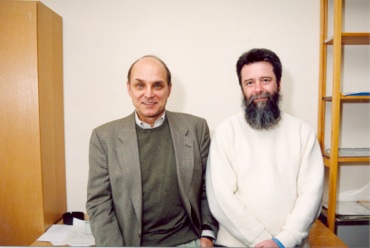
Left: “Papa” Midal, Gordon Baym (in background), T. D. Lee, and Hemlut Satz. Right: Helmut Satz and Fritjof Karsch
One of Helmut’s students was Fritjof Karsch who is now well known for his work on QCD at finite temperature and density using lattice Monte Carlo methods. He now runs a group at Brookhaven National Laboratory (BNL), where I work, doing forefront computations using the worlds fastest computers.
At this meeting, Rob Pisarski gave a talk about his work on QCD at high temperature. He was trying in understand aspects related to the vacuum properties of the theory, and to the Chern-Simons charge.
(Chern-Simons charge is explained in the section Physics.) Rob is my colleague at BNL, with whom I am now actively collaborating.
I also made friends with Andrei Linde, who was developing his theory of the inflationary universe for which he is now famous. He also presented arguments which showed that one could not compute as an expansion in the interaction strength at finite temperature beyond a certain order.
There were two Polish physicists there with whom I began to form friendships that have lasted through the years, Krzysztof Redlich and Ludwig Turko. Krzysztof barely spoke English, and at the meeting he was verbally beaten up badly by Johann Rafelski. My friend Ebs Hilf from Darmstadt, whom I had met during his visit to Seattle a year before, got so angry that he in turn stood up and verbally obliterated Rafelski. Krzysztof emphatically states that this was all very good for his career. Ludwig Turko was very stubborn, forceful and honest. Later, he was jailed for supporting Solidarity after the Polish Communists crushed that movement. Ludwig eventually became a member of parliament, before tiring of politics. He recommends neither jail nor politics.
Keijo Kajantie, the central figure in Finnish theoretical particle physics, and I began talking about how to think about high energy nuclear collisions. This was the start of a very long collaboration, which continues today with young people with whom we have both worked.
Helmut and I developed a very strong personal friendship based on our mutual interests in all aspects of the field. We have been to many mountaintops together, and shared memorable times.
At nights, we younger folks would go to the Ambassador Club and spend the night until 2 or 3 in the morning talking about science, people and other things. The Ambassador Club was in a dark alley. You rang a bell, and then a slot in the door would open. They would look you over and let you in. Andrei Linde remembers I would always tell him “Just relax!” whenever he got excited by anything. He nowadays returns the favor, at a time suitably chosen.
I most strongly recommend young physicists attend conferences and schools. It is rare that there is one which proved so influential in the development of a field as did that one at Bielefeld, but such meetings are almost inevitably where young people make professional friendships that last their lifetime. Friendships in science are very important. They transcend culture and politics. There are times in ones life when everything is very dark and your friends help you, or you help your friends.
My friend Ebs Hilf began encouraging me to attend the Hirschegg meetings in Austria which was run by his school, The Technical University at Darmstadt. I would meet Helmut, Keijo, Ludwig and Krzysztof again there. I also learned how to ski there, and have over time become a reasonable skier. Skiing is also a useful skill for a theoretical physicist. Many meetings attract good people by taking place at a ski resort. It sounds like a boondoggle, but it is not. People work very hard in mornings and evenings and ski in the afternoon. You can usually book a hotel inexpensively late in the season. During the time you ski, you have a chance to think and discuss, and shy people begin to relax. Good ideas cannot be generated by linear thinking, and many times arise when confronted with new information in settings that gives your mind has time to get outside of itself. I have for many years now been on the Organizing Committee for Recontres de Moriond, which is a meeting each year in the Alps that also features skiing. It now focuses on young scientists, and was very important for me as a young scientist. It is one of a set of meetings founded by my friend Tran Thanh Van, and these meetings have been a source of many new ideas and lifelong friendships.
At one of the Hirschegg meetings, Ludwig and Krzysztof had a harrowing journey. They got permission from Poland to go to the meeting, but they could only go through Austria, and were not allowed to enter Germany. Hirschegg is a mountain valley whose only entrance is through Germany; the Polish authorities did not understand this. The two scientists somehow evaded the Austrian and German border police.
This was a feat equaled by Krzysztof about a year later. I had organized a meeting in Seattle and invited Krzysztof, but had no information that he would be able to attend. The day before the meeting began, I got a phone call late in the evening, and it was Krzysztof. He was at the physics building and he wanted to know where he was to go. He had apparently been given a plane ticket only to Montreal, Canada, and no money. At the Montreal airport, he met some Poles (whom he had not known before) who lent him enough money to get a plane ticket to Seattle. He arrived at Sea-Tac airport, and somehow figured out how to take public transportation to the airport, something few residents of that city ever learn. He got to the University late in the evening, convinced someone they should let him in, found a phone and a phone book, and called me. Krzysztof has always been a shoot first and ask questions later person. He explained to me that when he was told he could travel, he simply had to leave, there would be no second chance. He figured he could make the rest work out -- and he did.
We went on hikes with Krzysztof and others during that meeting. We found a lake in the Olympic mountains surrounded by blueberries that was full of fish. There were bears nearby so we spent hours talking about how important it was to wash your hands before you went to sleep, since the bears really love the smell of fish. Krzysztof fished until well after dark since every time he put his fly in the water, he got a fish. We tried to find a place to sleep some distance from Krzystof.
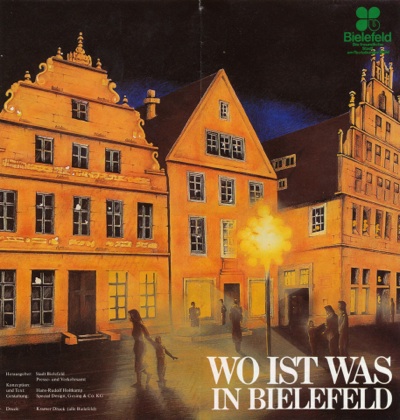
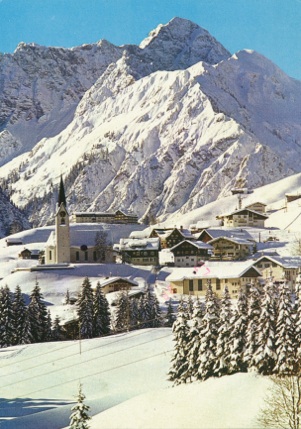
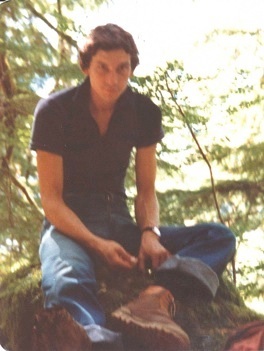
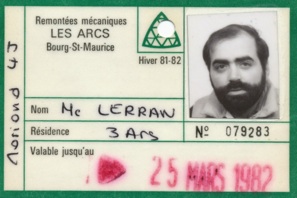
Top Left: Downtown Bielefeld
Top Right: Hirschegg in Winter
Bottom Left: My ski pass from my first Moriond meeting
Bottom right: Kzystof Redlich in the Olympics
About this time, Alice and I went to Helsinki Finland to spend a spring. When we arrived there was still snow on the ground, and that beautiful twilight you only get in the far north. I settled in to work with Keijo Kajantie where we developed our ideas about the space-time structure of heavy ion collisions. Much of this is described in the sections Alice, or found in Anecdotes in the discussion of Keijo Kajantie and Vesa Ruuskanen
About this time, the Isabelle accelerator project at Brookhaven National Laboratory was canceled. There was much discussion about whether to use what was constructed of the accelerator as the beginnings of an ultra-relativistic nuclear collider. This would provide a good experimental environment in which to test some of the ideas concerning the properties of high energy density matter. In 1983, I was part of a group participating in writing the long range plan for nuclear physics, and the nuclear physics community accepted this as its highest priority for new construction. This resulted in the RHIC accelerator at BNL, where I now work.
I thought my physics was going very well, but apparently my colleagues in the high energy theory group felt otherwise. I remember when I was gone on a trip and Alice had lunch with a fellow faculty member, Steve Ellis, and Steve more or less told her that he did not expect me to become tenured. Part of the issue was that when I was hired, the group also hired Tony Zee, a theorist who had not been promoted at Princeton. I knew Tony most from his computation of the dependence of interaction strengths on short distance scales for almost all theories. He neglected to do the one for the theory which proved to be correct. David Gross, David Politzer, and Frank Wilczek received the Nobel prize for that result.
In any case, Tony had very definite ideas about where he wanted to take the group, and it was not in the direction I wished to go. He told me that my work would never be important and that I should work on what he told me was exciting. Tony had a postdoctoral fellow who was a former student who had followed him to Seattle, Steve Barr. Steve Barr and I became very good friends, and I remember one time walking home from work with Steve we talked about recurring dreams. We discovered we both had the same one: we both had independently dreamed we had murdered Tony.
Steve Barr is now on the faculty of the Bartol Institute of the University of Delaware. He has written some very deep books on the relationship between science and religion. I remember him as a very serious young man, who was taken at midnight once a week by his soon-to-be wife, Kathy, to the Rocky Horror Picture Show.
In fairness to Tony, the feeling that I was going in the wrong direction was pretty uniform within the particle theory group. My former advisor Lowell had an almost allergic reaction to anything associated with nuclear physics, and he has consistently had very little interest in any of the problems on which I have chosen to work. Marshall Baker was supportive throughout, but felt that for my own good it might be best if I moved on. Marshall was right.
I had a discussion with David Boulware about these issues of 25 years ago recently when I was visiting Seattle. David had vocally opposed my promotion. David was a member of the particle theory group at that time and is presently chair of the physics department. I volunteered to him that one of the few good things about age is that it lets you see things from multiple perspectives. It was clear I was in the wrong place at the wrong time.
I should also say that Lowell and I remained on a friendly basis. After that time in Seattle, we would meet in Aspen and ride bikes together. I helped organize his 70th birthday celebration in Santa Fe.
I remember once after a seminar in which a colleague, Genya Levin, had asked many questions and after each one was answered with a clever joke which made Genya look not so clever. After the seminar he told me in a loud and angry voice, “This was not fair. He did not answer my questions.” A young theorist, Yuri Kovchegov, came over and said, “Genya, there is an old Russian saying: Don’t shake your fist after the fight is over.”
In spite of the negative signals I was getting, I decided to request to be considered for tenure. Larry Wilets was chair of the committee, with Mike Schick and Vlad Chaloupka the members. They considered the case, and recommended for tenure, which was approved by the department over the objections of most members of my group. The recommendation was then forwarded to the University where it was subsequently approved. I owe much to the three people on the committee, and to the members of the department who supported me. Ernie Henley, Dean of the College of Arts and Sciences at that time, was also very helpful.
The approval by the department took place while I was in China. My friends Gao Chong Shou and Huang Tao had arranged for me to attend a workshop run by Liu Lian Shou in Wuhan. I was to visit
Peking University and Tsinghua University in Beijing, Fudan University in Shanghai, and universities in Canton and Hangzhou. I was able to support the trip because of a Sloan Foundation Fellowship which I had recently received
I first crossed the border to Canton. I was surprised to see the bicycles filling every street, and whole families sharing a single bike. I gave a lecture and we went out to dinner. The physicists would mix their beer with orange pop. I then went to Guilin where I was alone for a few days, toured the magnificent rock formations, and took a boat down the Li river.
I took a train from Guilin to Wuhan. I was the only westerner on the train. I shared a compartment for some time with a high officer in the People’s Army, but after a few hours, he found he could shift to a compartment by himself. When I arrived in the morning at the Wuhan train depot, about a thousand people got off the train. I started looking around for my friends from the meeting and I did not see them. After about an hour almost everyone had left. A young lady in a blue Mao pant suit came up to me and gestured to me to follow her. I followed her to her car. She then made gestures indicating she needed to know where I wanted to go. By this time I knew she was a sort of taxi driver. I pulled out my invitation to the meeting which had some Chinese characters on it. She picked it up, looked at it, rotated it, looked at it again, went and talked to some people, came back and looked very confused. Then she motioned that I should get in the car, and away we drove in her aging Shanghai. We drove for about forty minutes, and came to a large gate. She got out of the car with a big smile on her face, which was replaced by complete confusion after talking with some people who looked equally confused. After returning to the car and sitting very quiet for a few minutes, she started the car, and we came to another gate, and the whole experience repeated itself. As she was going back to the car, a woman came running out of the gate. They began to talk in loud voices, and soon both had huge smiles on their faces. The woman at the gate led the car up to a building on the university campus, went inside and brought out a smiling Liu Lian Shou, the meeting organizer. His wife was going shopping when the car arrived at the gate. There had been confusion about my arrival. My friends had gone to the train depot the day before, had not seen me, and assumed I was somehow not coming to the meeting.
A few minutes later, I was taken to the lecture hall and began the first of eleven lectures. This was the first meeting on problems of matter at very high energy density held in China. Now there are several large groups from China working at BNL and at the Large Hadron Collider (LHC) in Cern. There are some very good theorists. At that time it was all new, and my American style English was difficult to follow as well. I eventually wrote up all eleven lectures, and they were distributed in China for some time, serving as an introduction to the field.
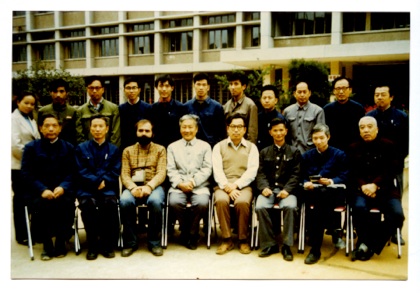
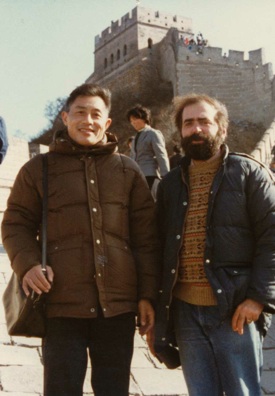
Above: Participants in the Wuhan meeting. On the far left is Liu Lian Shou, the organizer. I am second from the right. Two more to the right is Gao Chong Shou
Right: Yu Ping Kuang and me at the Great Wall
There were a number of young women at the university who were teaching English as a second language. They told me that their mail was being regularly opened, so I began writing letters back home to Alice praising all the propaganda toasts I had heard at banquets. I always believe you gotta take care of your friends, and I wanted the authorities to know that the proper impressions were made. Alice thought I was Loony Toons.
They also told me they were increasingly worried by crime. At that time there was little, and the police, expecting law abiding citizens, were largely unarmed. However, an incident had recently occurred. Two brothers had broken out of jail in Shanghai and were robbing banks up and down the Yangtze River. They would go into a bank and demand the money. An unarmed policeman would approach telling them they must stop what they were doing and come with him to the police station where they would be arrested. One of the brothers would pull out a gun and kill the policeman.
One night I went with a few people to a dinner at an apartment of one of the women. We stayed up talking till almost 3 in the morning. When I returned home I was locked out. I knocked on the door and got in because Gao was waiting up for me. People were worried that something had happened to me. Twenty five years later at a banquet in Wuhan, the vice president of the university, who was at that time a young physicist, only wanted to know one thing from me: Where had I been that night I came back so late?
I later went down the Yangtze river and vacationed a few days in Huang Shan. Alice has beautiful photos on her web site from a recent trip. It is one of the most spectacular places I have ever been.
I went hiking with a young man who had graduated from Peking University with a degree in English.
Peking University is the Chinese equivalent of Harvard. The best job he could get was to escort tourists. He had only two teeth left and he used those to open bottles of beer. When I returned home I sent him a huge dictionary, that he received successfully.
Top left: Exterior of our home in Minnesota
Top right: Alice playing the harp.
Bottom left: The living room
Bottom right: Our monkey statue in the room which Alice designed
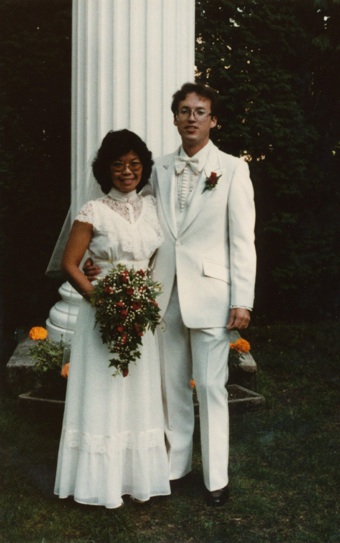
These were funny times. It was right after the demise of the Gang of Four and Mao’s death. Mao statues had been taken down all over China. At one university, I was walking down the stairs to a basement and there was a huge Mao statue stored on roller wheels. I asked why he was on wheels, and was told that times may change. He might be rolled out again. There was no discussion of politics with Chinese scientists. I viewed this as fear. I suspected from some trips in the country that many scientists had been in prison during the Cultural Revolution, since colleagues would explain to me in great detail how hard it was to work on road gangs explaining the details of everything which was done. There was never direct discussion, perhaps only vague hints.
I was fortunate to travel in the countryside, and whenever I return to China I try to visit there. I believe the most significant change in China will come when the peasants live better, have more modern housing, and better opportunities for their children.
While going down the Yangtze River on a the river boat, I was able at one stop to call Alice. The connection was awful, but I found out that the physics faculty had approved my tenure.
I was the only westerner on the boat for much of the trip. For half of a day, there were two aged Canadian women who had come back to search for the house they were born in when their parents were Christian missionaries
I arrived in Shanghai, the only westerner in the boat terminal. Shanghai of that time was not a modern city. With the exception of one peasant woman in the terminal, everyone wore a Mao suit. The peasant woman had a wide and colorful dress, and was carrying a beautiful little girl. I understood that at that time a smile in China did not reflect friendliness but nervousness and apprehension. Nevertheless, the little girl smiled at me, and I was so charmed that without thinking I smiled back. The little girl buried her head in her mother’s dress and cried with fear.
I visited Fudan University in Shanghai, and later Peking University and Tsinghua University. At Tsinghua Universty, I met the Kuangs, a married couple who are both theoretical physicists, and with whom I have maintained a friendship.
I had planned for the possibility that I would have to leave Seattle. That winter, Alice and I had visited Fermilab (FNAL) for three months. FNAL subsequently offered me a permanent position in the theoretical physics group. I also had a tentative offer at Brookhaven National Laboratory, and feelers from other places. The physics was in my opinion enormously better at FNAL or BNL than at Seattle, and the atmosphere friendlier. I chose FNAL largely because of James Bjorken who was on the staff, because it was the most active in experiment at that time, and because they had the beginnings of a first rate astrophysics group. It was difficult to leave Seattle because of so many friends and family and because it was a wonderful place to live. In terms of physics, the decision was obvious, and Alice and I have never regretted it.
Before leaving Seattle, we had one last celebration, one with echoes of Romeo and Juliet. Two physics students, Larry Carson and Shi Hung, had earlier fallen in love there, but each set of parents was firmly opposed to the match, nor could the two find postdocs in the same part of the globe. Sadly, they decided it was not possible to follow their hearts. But when they suddenly encountered each other at the place where they had first met, they threw caution to the winds and asked the friends around them to help organize a wedding: the physics community is a family, after all. We had three days after the license application to accomplish a moving wedding -- and we did it. Alice and Shi Hung found a lovely dress on sale for a miraculously low price, and a sympathetic clerk in a shop specializing in wedding veils sold them materials to duplicate the one that caught Shi Hung’s eye, and Alice sewed it up overnight. . They were married on the University of Washington campus in a beautiful green area with white columns where they had often shared picnic lunches as students. Presiding was a silver-haired judge in robes, and all their friends were there. We had the reception at our home, which was a potluck affair much like my wedding with Alice. We both remember watching Ernie Henley in the kitchen, cutting bread that he had baked himself.




Huang Shan (The Yellow Mountains) as photographed by Alice in November of 2007
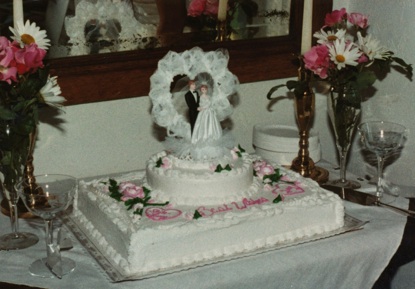
Larry Carson and Shi Hung at their wedding, their wedding cake, and Shi Hung with our cat Zelda
Scientist at Fermilab: 1984-1988
During the summer between leaving Seattle and moving to Fermilab, Alice and I took our first trip of many to the Soviet Union. During my visit to Helsinki several years before, I had met a trio of Russian scientists at the Arctic School of Physics in Akaslampalo. This was a wonderful meeting held in late August, north of the arctic circle. In August it is light late into the night, but cool enough so that an evening frost kills most of the mosquitos. I fished at night with Russian and Finnish friends, and Alice danced with the Russians, who loved to dance, and with the occasional “reindeer cowboy” who dropped into the hotel. (Finns like to dance too.) The Russians were Mitya Diakonov, Yuri Makeenko and Misha Shepkin.
For the Russians it was exciting to travel. The Soviet government rarely would allow its scientists to leave Russia, fearing they would not return. Of those who did travel, some were required to report on minor indiscretions of the others, and rarely would a good physicist be able to travel twice.
Our Finnish friends taught us a lot about Russian science and scientists. Perhaps the most important rule I learned was never to cite what a Russian scientist had told you about people, politics or society. There was no way to predict what would cause trouble. Alice and I were also careful never to talk of such matters between ourselves while in Russia. You never knew where there were listening devices .
There is one famous apocryphal joke about a scientist who was staying in a Russian hotel. He has heard that the rooms are monitored, and he carefully inspects everything. Underneath a rug he discovers a funny looking brass button. He carefully unscrews it, and as he does so he hears a loud noise. He finds no electronics in the button and eventually goes to sleep. The next morning at breakfast he hears a couple saying, “Boy that was weird last night, I don’t understand how that huge chandelier could have fallen from the ceiling.” Jokes aside, I was assured by people both in Russia and the US who would know that rooms used for scientists in the hotels, were monitored.
Alice and I arrived first in St Petersburg by train from Helsinki. It was our first experience in a Russian train and it was nice. We had a first class compartment to ourselves, and tea was served in glasses with silver coated metal holders. We were met at the train depot by our host Mitya Diakonov, who then took us on a tour of the city. The first memorable building we passed was the Leningrad KGB center, the “Big House”. This building supposedly had several floors underground, including a crematorium, so that unlucky prisoners could have their ashes discretely dumped in the nearby river. As we drove by, we were given a prepared speech about how it was important to refrain from political activity and illegal currency exchange while in Russia. On this trip, I met Mark Strikman, Leonya Frankfurt, Alyesha Anselm and Genya Levin who together with Mitya remained our good friends. I also met Leonya Gribov, the son of the famous Volodya Gribov, who I remember as a very entertaining and bright young man. He was to die in a mountaineering accident a few years later on a trip with Mitya in the high Pamirs range. I met Mitya and Mark’s families at dinner parties where we would talk with animation and enthusiasm until the early hours of the morning .
I was intrigued by the intensity of positive relations between people. This was driven in part by the harshness of life in Soviet Russia. Nothing really worked very well, and there was little food or other commodities in the shops. In addition, there was a controlling incompetent government that wanted to have a formal submission to its power. Friendships gave life a certain richness that compensated for these bleaker realities.
Mostly, the Communist Party was the subject of joke and ridicule. My trip to China, this trip and subsequent trips to the Soviet Union and to Eastern Europe began my political re-education. Like most young people who grew up in the 60’s, I was considerably left of center After visiting Communist controlled countries, and seeing the corruption, cynicism and utter folly, it became very difficult to accept that there was much of value from such political philosophy.
I remember on a plane trip leaving Uzbekhistan where I was sitting next to the wife of a physicist friend. She was a reporter for the leading Communist paper in France, L’ Humanite, and I asked her what she thought of her visit. She was visibly shaken. She had never expected the conditions to be so bad, nor Communism to be a subject of open ridicule. She felt it must be a Russian cultural problem.
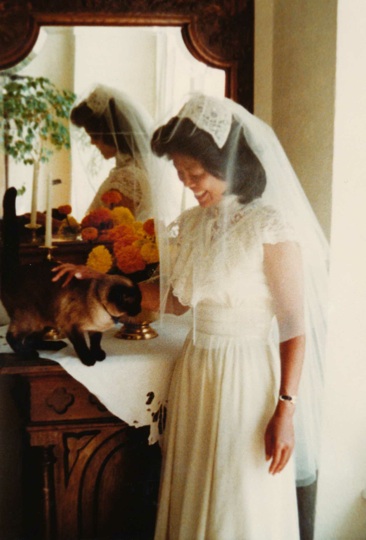
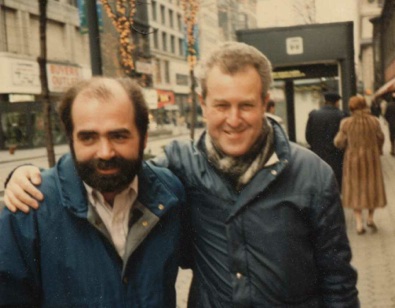
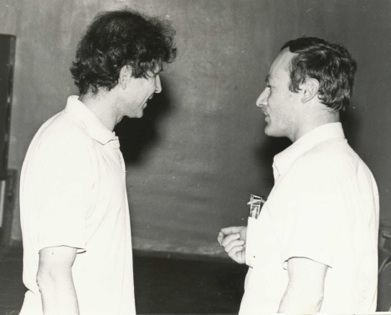
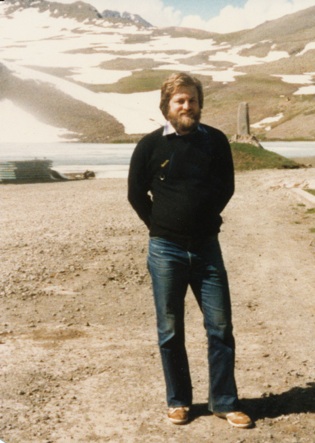
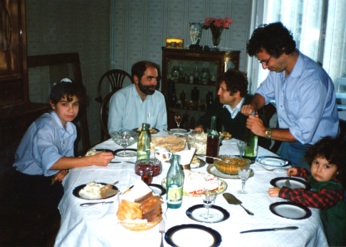
Top left: Yuri Makeenko near Mt. Aragats in Areminia
Top right: Marshall Baker and Mitya Diakonov at the Leningrad Nuclear Physics Institute
Bottom left: At the Strikman home with Leonya Frankfurt
Bottom right: Alyesha Anselm and me in Minneapolis
Right: On an early visit, dinner with the Diakonovs and Strikmans at the Diakanov home
Upon arrival in Moscow, we were met at the train, and driven on a tour of the city. We went by the Lubyanka, which is the KGB headquarters in Moscow, and were given much the same speech as in St. Petersburg. We were also driven by the famous apartment building in Moscow which housed party members during Stalin’s era, and told the horror stories of police in the middle of the night, a forced march to one of the monasteries which ring Moscow, and eventual imprisonment and often death in Siberia.
We were housed in the Institute for Theoretical and Experimental Physics (ITEP) apartment in Profsoyuznaya Square. I learned to use the metro, which was about the only thing that worked well in the Soviet era. It was fast and efficient. Rumors were that Stalin had shot drivers of late trains.
The ITEP guest house had radios everywhere. There was even one in the bathroom. On the last day of our stay, I was talking with Alice asking her if we had enough cash to pay for the apartment. A few minutes after I said this, there was knocking on the door, and the landlady came in asking for payment.
She was probably listening to the radio.
The first night we were there, we went looking for a place to eat. This was always a problem in Russia. The restaurants were run by the state, and the waiters and cooks all received a guaranteed salary. Food was also scarce, and so when a restaurant got a supply of food, the employees likely would take a fair amount, leaving little to be served. The manager of a restaurant might minimize all difficulties by serving no customers. However, if no customers were served for a long time, the restaurant might close, and although jobs might be permanent, the next one might not be as easy.
We were standing in front of a restaurant feeling frustrated and confused (most tables seemed to be empty, but we had just been told they were all reserved) when Karin ter Martiroysian, from ITEP, saw us. He got us inside, ordered for us, and left. After about a half an hour, a pleasant waitress with no English came to our table, and tried to explain something to us in Russian. It was apparent that they no longer had what Karin had ordered for us. We could not understand what she tried to communicate she could offer us instead, as I knew almost no Russian at that time. Finally, embarrassed but desperate to help us understand, she lifted her elbows and flapped them, and with blushing managed a very communicative, “CawROK-rok-rok!.” Chicken! Up until that point, those in the restaurant had seemed very quiet and ill at ease with Americans there, broke into laughter. One fellow introduced himself, and said he spoke a little English. He ended up joining our table, and the evening became a pleasant and sociable one..
The last time I was in Moscow, my friend Yuri Makeenko insisted that we go to the Last Soviet Restaurant in Moscow. We arrived at the door, and they would not let us in. There was a wedding taking place. After negotiating for some time, the owner let us into a little table hidden under a stairwell. They brought us a huge menu, which just like the old Soviet menu which had all possible foods and wines. When they came to take our order, they (again, just as in Soviet times!) had nothing of what we had chosen. However, the waiter said they had a couple of meat dishes, he had a good Georgian wine, a good bottle of vodka, and even a little black caviar. Strangely enough, in the old days, restaurants would sometimes have nothing but caviar, champagne, vodka, bread and butter. You can do worse. I settled into the restaurant feeling like I had stepped back in time 15 years, and felt at home.
I met people truly outstanding for their science and human values while at ITEP. Some were senior people like Karin ter Martiroysian, Lev Okun, Boris Ioffe and Yuri Simenov. Many of the young people have become my colleagues and I have spent many days and nights talking with them about physics, politics and literature: People like Yuri Makeenko, Misha Polikarpov, Misha Voloshin, Arkady Vainshtein, Sasha Dolgov and Vitya Novikov. Alice and I remember going to the Tretyakov Gallery with Misha Polykarpov. There were truly wonderful icons by the great Russian painter Andrei Rublev. A few rooms further on, there was the Socialist Realism painting. I was intrigued by the starkness, and lack of human feeling in the art. It was cold and mechanical, and I was fascinated the ugliness of it. Alice simply disliked what she saw, and she and Misha Polykarpov almost raced through the gallery, and waited for me outside. Alice reported that when she remarked on how the art reminded her of the unrealistic ending of “Spartacus,” the ballet we had seen the previous evening, Misha Polikarpov turned to her and said quietly, “Alice, you are in Wonderland .”
When you left Russia by train, there was a little train depot on the Finnish side of the border. They had a snack bar, and you could buy good cold Finnish beer. There were sausages being fried in the open air, and all manner of fruit on the shelves. I have always loved Finland very much, but perhaps not so much as those first few times I was leaving Russia. I also enjoy Russia and Russians very much, but in that era it was a hard adventure, and the arrival in Finland felt like a warm shower after a long and exhausting backpacking trip.
Upon arrival at Fermilab, we bought a house in Batavia, Illinois, about 3-4 miles from the laboratory. It was a former parsonage, and was in pretty good condition. It had beautiful wooden floors and high ceilings. We planted cherry trees in a portion of the lot.
Conditions at the lab were truly phenomenal. There were two theoretical physics groups. I was in the group run by Chris Quigg in particle theory, and there was another group founded by Dave Schramm
and managed jointly by Rocky Kolb and Mike Turner on particle astrophysics. The theorists were all people of great depth and accomplishment without the personal eccentricities that plague so many groups of talented and creative people. Everyone talked with everyone else, and people genuinely enjoyed one another’s company. There was true intellectual excitement not only about new ideas in theoretical physics, but also new experimental results from the lab and elsewhere. There was also a fusing of ideas from particle physics and field theory with astrophysics and cosmology.
I would ride my bike to the lab during the summer, spring and early fall. I remember being locked out of the central office building once when I arrived in the middle of a tornado drill. Others, it seemed, were at the same time locked in. I discovered this was a government safety regulation.
In the winter, there was cross country skiing on the lab site. The lab site at Fermilab has restored the prairie grass inside the main accelerator ring. The lab originally planned to have buffalo grazing there, but the buffalo loved the most exotic and rare of the prairie grasses planted there at great effort by volunteers. They were moved to another area, where their fine taste in food caused less trouble.. Excess buffalo would be sold off at a yearly auction. At one such sale, a bull buffalo escaped. He made it all the way to the Fox Valley Mall, many miles away, enjoying his hard earned freedom with a carefree stroll through suburban neighborhoods, before being tranquilized by a lineup of Illinois State and local police.
There were ponds near the central office building for the lab, the High Rise, where warm water from the magnets in the accelerator was allowed to cool. Geese flying south in late fall would look down at the unfrozen ponds, and decide to fly no further. By midwinter, the ponds were closely packed with geese whose collective motion resembled an ice floe. We heard that the lab would quietly collect geese in the middle of the night, using helicopters and nets, and take them off in a truck to Southern Illinois. They monitored the geese and found that in a few days they would return to Fermilab.
I was active in the discussions concerning the Relativistic Heavy Ion Collider at BNL, and a member of the RHIC Policy Advisory Committee at BNL. I also participated in the workshop where the first plans for detectors were drafted. I wrote many papers on the phenomena which might be expected from RHIC collisions. I developed fluid dynamical models of the collisions with Henrique von Gersdorff and Vesa Ruuskanen, Keijo Kajantie and their groups.
Peter Arnold and I worked out details of electroweak baryon number violation, which is described in the Physics section of this webpage. Working with someone who has a mind as original and creative as Peter’s is exciting. Peter takes an incomplete and poorly thought out idea, reduces it to its most simple form, and then finds a simple mathematical abstraction of it from which he can test its validity. Sometimes this leads to a reformulation of the basic concepts, and then a partial or complete solution.
In 1984, I went to a meeting in Bad Honnef, Germany where I met Edward Shuryak and Evgenii Feinberg. Richard Wiener organized this wonderful meeting, and through his understanding of the Soviet scientific bureaucracy, enabled these two outstanding Soviet scientists to attend. Evgenii was a senior and distinguished theoretical physicist from the Lebedev Institute in Moscow. This is the institute of Andrei Sakharov. Evgenii was a tall man, grey haired and soft spoken, who was proud of his resemblance to Ronald Reagan. There is a reminiscence of him in the Anecdotes section. Evgenii had thought very hard about fluid dynamical descriptions of particle collisions, and I learned much from his reflections on entropy production.
We also got into a conversation on ESP. I had heard the Russians were seriously testing the idea, and asked him if it was so. He said yes they were, and they had reproduced all of the exciting results which we had in the US. This was Evgenii’s way of saying there was no reproducible effect.
I knew Edward earlier from his work on strongly interacting matter at very high temperature. We spent much time discussing one another’s ideas, and became very good friends, Edward is very fast, and you do not have to explain details. He is very creative, but most importantly he is obsessive. Most of my good friends are obsessed to a certain extent by ideas, paradox and paradigms, but Edward is far in the tail of the distribution. With Edward, I would have unending excited conversations.
In April of 1986, I was to attend a meeting in Kiev organized by Genya Zinoviev. I had met Genya through my colleague Helmut Satz who organized a number of influential meetings at the Center for Interdisciplinary Study in Bielefeld, Germany. By this time, Helmut and I had become very good friends, both through talking with one another at various scientific meetings, and hiking and skiing in the mountains. Helmut is very intense; he expresses himself clearly and simply. He did some of the earliest and best work on the numerical solutions to strongly interacting theories of matter at very high energy density. He also did seminal work on the experimental consequences of such matter for high energy collisions of nuclei.
Genya was Helmut’s good friend, and was trying to build a group similar to Helmut’s that would work on the properties of high energy density matter at the Academy of Sciences Institute in Kiev. Genya had access to ample resources, since one of the founders of his group was well connected to the high party leadership of the Ukraine.
I had planned to stay a week in Leningrad before going to Kiev, but before we reached Leningrad,
Chernobyl blew up. Apparently, the scientists in the Leningrad Nuclear Physics Institute discovered the Chernobyl explosion before it was public knowledge. Some of them were going into work and upon entering the reactors, the radiation detectors went off. These detectors are placed there to go off if you have been unknowingly dosed with radiation while at work and are leaving the reactor. They were quite surprised that they had set them off on entering. Upon testing themselves with different detectors, they verified that they indeed were hot. This of course scared the hell out of them, since there were a number of reactors in the Leningrad area and the Soviet government had never been particularly forthcoming about catastrophic events.
While in Leningrad, Alice and I were encouraged to go to the meeting in Kiev. We were told there was no problem getting there and no real safety hazard in Kiev. Both of these things were true. A more real problem, however, was that the meager public transportation system of the Ukraine was crumbling under the pressure of terrified crowds mobbing train depots and airports. One could go to Kiev but not leave. It was also not clear at that time, nor even now for that matter, how things would eventually settle in Chernobyl.
I visited Kiev several years later where Genya Zinoviev was my host, and was introduced to Kirill Bugaev and Yuri Sinyakov. Genya had by then built a successful group in Kiev, and is now a central figure in the involvement of Ukraine with the CERN experimental program. While in Kiev then, I visited the war memorial where there is a huge dome, and inside the dome are given the names of war heroes. Brezhnev had once been high on the list of names displayed there, but had fallen in place on the list after his death. I learned during that visit about Bulgakov, about the bitter fighting in the Ukraine during the Russian Resolution, and the starvation there during the collectivization of the farms. The pattern was that Communist Party bureaucrats would go into an area to collect grain. They would be rewarded for exceeding the quotas that they had set for their areas, since the excess was interpreted as successful increase in productivity. But the next year’s quota would then need to reflect this assumption of increased productivity, and be higher than that of the prior year. The result was that the farmers and their families would starve to death. But the Communist Party bureaucrats did not care, since farmers were land owners, and therefore enemies of the people. This pattern was taught to the Chinese, and later with some variation to that most respected and illustrious alumnus of the Sorbonne, Pol Pot. Pol Pot, to his credit, understood that the educated were more of a threat to his ideology than the peasants, so he systematically liquidated them as well.
Once while in Russia, after I had learned to speak a little Russian, I met the father of a well known physicist at a dinner party. It was late and we all had a lot to drink, but I started talking with the old fellow. He was a party member, so I asked him how he could defend the slaughter of tens of millions of people in the Ukraine and in the Gulags. He answered me honestly: These people were enemies of the people. There was class warfare. In war, you kill the enemy.
I should be careful here, because some of my friends to this day remain Communists. They are not evil people, nor do I disagree with all that they say. Many of these friends I respect very much for their idealism, Their conception of a better world is certainly not that of a Stalinist, a Red Guard or a Khmer Rouge.
During the visit to Kiev, Genya took me to visit an old broken down house on the site of his institute. It had the architectural style of a California ranch house. There were the remains of a swimming pool. I was told that after the famous physicist Dirac retired under mandatory retirement laws in Britain, he was being recruited for a position in Kiev, and the house was part of the deal. Dirac eventually accepted a position at an American University.
Several months later, I returned to Russia as part of a DOE delegation to visit Soviet laboratories. We visited, Novosibirsk, Dubna, the Lebedev Institute the Kurchatov Institute, ITEP, and the Institute for Nuclear Research. Alice and I would stay with the delegation during the day, and at night would visit with friends late into the night. I think the purpose of the delegation was to exploit the rapidly warming relations with the Soviet Union by first understanding what the various labs do, and then trying to develop programs of mutual interest. I remember after visiting a reactor complex in Dubna, Dave Hendrie, the leader of the delegation insisted we all wash our hands. We saw a number of laser laboratories, suggesting that they had the same interest in high powered lasers that we had in the US. At the Kurchatov Institute, they still had proudly displayed in their meeting room pictures of the reactor at Chernobyl, a reactor that their lab had designed and built.
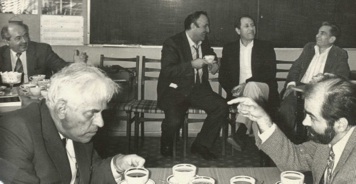
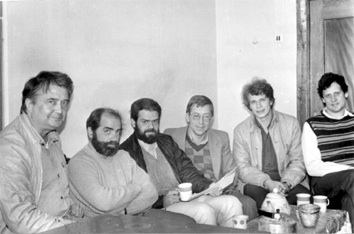
Top Left: Genya Zinoviev, me, Yuri Sinyakov and Kirill Bugaev in Kiev
Top Right: With the DOE delegation at the Institute for Nuclear Research
Left: Me and Andrei Smilga waiting out a storm in Armenia
Right: Uri Maor, Mark Strikman and me in Samarkand
During this trip, there was a young man assigned to us who I assumed had direct connections to the KGB. Alice was at that time was trying to reach a Russian author, Natalia Romanava to see if there had been a decision in Moscow regarding publication of her book in Russian translation. At one point, with members of the delegation preparing to go somewhere, and Alice was still trying to reach her friend as this fellow was in our room, waiting impatiently for us to join the others. After she had tried unsuccessfully several times, he walked across the room, took the phone, and dialed the number. He had determined and memorized the number while listening to Alice dial from across the room. I was impressed. He also successfully made the call.
I met Evgenii Feinberg in Moscow. I took him to the only open restaurant in our hotel, one that had a band playing loud music. The only food was champagne, buckets of black caviar, brown bread and butter.
Alice and I had a wonderful time seeing our friends during this visit. The problem with delegations is however that delegations are stigmatized by the behavior of most boorish of the lot. One person would not stand when the famous academician Cherenkov, then 70 years old, came to visit with us. At restaurants, some members of the delegation were indignant when the restaurant did not have everything listed on the menu. I guess after this trip I figured I had been there and done that. No more delegations for me.
I made several other trips to the Soviet Union during the time at Fermilab. In 1987, I went to Tashkent in Uzbekhistan for the Multiparticle Conference. Uzbekhistan is part of Middle Asia, but there happens to be a significant Korean minority in Tashkent, deported there by Stalin deported during the war.
During this meeting, my friend Genya Zinoviev suggested we go off for a few days to the countryside and stay in the mountains with Kazaks. He said he had a friend with a car. Years later, when telling this story with Genya present, a colleague asked Genya the name of this friend. Genya laughed in an embarrassed way and did not answer. I was told to take the key to the hotel with me since then the hotel staff would not know that I had left. This was not very plausible, but I wanted to see the mountains and the Kazaks, so I followed instructions. I figured this whole expedition had been approved by the local authorities.
We drove through huge wide valleys full of sheep. At this time, there was an anti-alcohol campaign under way, and we wanted to find some vodka, so we drove around one city until we saw a huge line. We stopped, stood in line for an hour or so, and bought a bottle.
When we got to the mountains we found the Kazaks, and settled into a Kazak tent for the night. The next morning we went swimming in a crystal clear mountain stream that had formed pot holes in a little valley about 3-4 meters below the surface of the land. I jumped in first and as I hit the water, I discovered the temperature was close to freezing. I knew that if I screamed Genya would not jump in, so I shut my mouth, went under the water, and when I came back up yelled with feigned delight, “Genya, Genya, the water is so warm.” Genya then jumped in, When he hit the water he felt no need to restrain himself, and let out a roar that echoed several times off the nearby mountains.
I have always liked Genya very much. He is a very tall man, generally quiet in disposition. I remember one time when he visited the University of Minnesota, he saw a squirrel, and said in a very loud voice, “Oh, little squirrel, if I had any nuts I would give them to you,” amusing some nearby young women. I had to explain to him that nuts were to Americans what eggs were to Russians. Yes, there is a double meaning to Lenin’s famous quote: “To make an omelet, you have to break eggs.”
While with the Kazaks we drank fresh kumiss -- fermented mares’ milk, the favorite drink of Genghiz Khan. The Kazaks were shepherds and expert horsemen. When on a horse, the rider would merge with the horse’s identity, and one felt there was a single living organism moving.
We also went on an excursion with the meeting to Samarkand. As we walked through the city, my Israeli friend Uri Maor discovered a group of Jews who had lived in the area for centuries. They were walking down the street speaking Hebrew. Uri followed after them and spent much of a day talking with them. In Samarkand, we visited the tomb of the great Khan Tamerlane. I was told a story about how a city in his empire had rebelled. He conquered the city and killed every living thing. He took the skulls of the people, crushed them to make mortar, and used the mortar to build the dome of a huge mosque.
On the trip to Samarkand, I met a Libyan physicist. He made a point of sitting with me at lunch, and we began talking. At that time. Ronald Reagan had recently bombed Tripoli. I asked him if there was much damage. He said no, that a big deal of it was made in the press, but in fact the bombs had been very accurate. There was little damage to the areas surrounding the intended targets. He was frank and honest, much like my Russian friends.
On a later visit to the Soviet Union, I went for a joint meeting of American and Soviet scientists on the slopes of Mount Aragats in Armenia. It was held in a guest house for cosmic ray experimenters that had been built on the mountain. Alice and I would go on afternoon hikes, and the photo above shows me and Andrei Smilga trapped during a thunderstorm. I made friends with George Saviddy, Iosif Khriplovich, Misha Shaposhnikov and Valery Rubakov. George knew all the mountain herbs and while walking would pick them and pass them around to taste. I was interested in the work Valery and Misha had done on electroweak baryon number violation. With Valery and Mitya Diakanov, we climbed to the snow covered top of Mount Aragats. To get to the starting point, we needed a taxi, and the organizer of the meeting wanted to block our trip. Valery very cleverly had arranged the taxi from a nearby village, not the one in which we stayed. Valery has always had great administrative skill. I discovered when I returned to the US, I had climbed Aragats with a hand broken in a fall a few days earlier while hiking with Iosif Khriplovich. From the top of the mountain, you could see Mount Ararat in Turkey, and a famous Soviet radar base, supposedly where they began tracking the U2 pilot Gary Powers as he entered Soviet airspace.
On one visit to Armenia, we were driving down the highway with friends, and we saw large groups of sheep sitting by the roadway. The sheep were listless and looked depressed. We stopped near one group of sheep and while looking at the herd, a man drove up, paid the owner of the sheep some money, grabbed the sheep he wanted by the neck, and put him in the trunk of his car. We learned that it was a religious holiday, and the sheep were being taken to be sacrificed. The sheep somehow seemed to sense what was going to happen -- but there was not much they could do about it other than to lie by the side of the road being depressed.
I was also developing many friendships in Eastern Europe. I began attending the Crakow School of Physics in Zakopane Poland. This school was founded by Andrzej Bialas and colleagues during the early 1960s. In my opinion, for many years this was the top school of theoretical particle physics anywhere. It brought people together from all of Europe, the Soviet Union and America. There was a good mix of student nationalities, together with a large number of young Polish theorists. The first meeting I attended was after the fall of Solidarity, and some American scientists were boycotting Poland. I believe that boycotts do only harm to the people you want to support most. In Communist countries, the scientists were among the most liberal and enlightened of the intelligentsia, and as such were the ones who were agitating for change.
During our first Zakopane meeting, Alice would go to food stores and find they had absolutely nothing for sale. Somehow the organizers could find beer, and create delicious and filling soups with almost no meat at all. Zakopane has now gone the way of many other beautiful mountain towns: It is full of new shops catering to tourists and junk food chains. The mountains remain beautiful, with unspoiled alpine meadows. You can read more about Zakopane in both the Anecdotes section on Andrzej Bialas and in the section on Alice.
During this first meeting I met the young Atsushi Nakamura, who is now at Hiroshima University. I was struck by how much he appreciated of Polish culture, and how he had visited many museums. Nakamura was also very direct in his discussion of physics and I have always found him to be a good friend with a wide appreciation of science, art and culture. He now plays a pan pipe, and is well known for this in Japan. Below is Atsushi improvising on the pan pipe together with Polish fiddlers at a Zakopane meeting held around 2006. Alice and I would hear this beautiful music drifting through the corridors of our hotel during that meeting, and it took a few days to discover its origin.
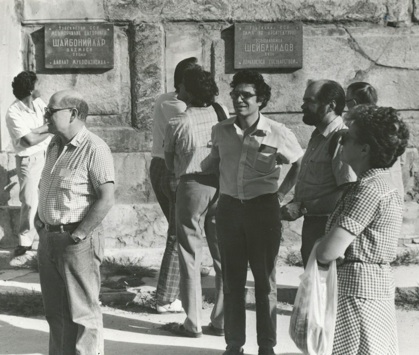
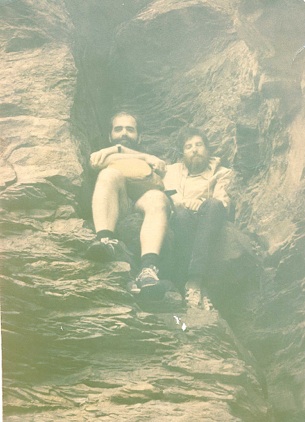
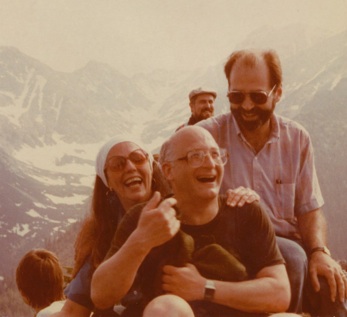
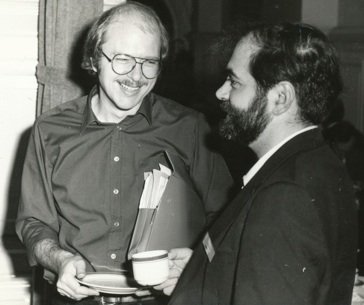
Top: Atsushi Nakamura playing his pan pipe at a recent Zakopane meeting
Left: Alice, Misha Shifman and me in Zakopane Right: Misha Ilgenfritz in Leipzig
I made a number of visits to Hungary and East Germany. In Hungary, I got to know the senior person in my area, Zimanyi, and attended a meeting at Lake Balaton. I learned to wind surf with a couple of East Germans. I was subsequently invited to a meeting in Georgenthal, East Germany, run by Gisella and Johannes Ranft. The Ranfts were true believers. Johannes had been working in a factory, when the party decided educate him, and he eventually ended up as the senior theoretical physicist at the Karl Marx University in Leipzig He owed much of his academic career to the Party. He built a group of young theoretical physicists.
I arrived by train and remember the harsh East German border guards who checked under train seats and unscrewed every light bulb. I never understood what they were looking for.
In Georgenthal, I would run in the morning, and return to the basement to shower. There was no hot water and it was winter. There were others “showering” by cupping water, then patting it on their bodies, swearing in several languages about the the cold. I visited Wiemar and while walking the streets, huge clouds of blue coal smoke would descend on me and it was difficult to breathe. I went out for a walk by myself one day in Georgenthal, and the Ranfts were scandalized; I Iearned I was not supposed to walk by myself, but should always be accompanied by an East German.
Misha Ilgenfritz was responsible for me on this first visit. Misha was also a true believer; he actually emigrated from West Germany to the East. He had a Trabant automobile, and he must hold the world’s land speed record for such a class of vehicle. It has an engine little larger than that of a lawnmower, and yet he got busted with me while driving 3 kilometers per hour faster than the speed limit on the East German Autobahn. I think the East German traffic cop was in a state of awe about how fast he got the car going. We must have been going downhill.
Alice and I went together to an international conference on high energy physics in Leipzig a few years later. On the train there, she shared a banana with a little boy who was sharing our compartment, upsetting the child’s grandmother, who I think was angry that the grandmother in her (who wanted the boy to taste a fruit unavailable in his town) had prevailed over the Good East German who wanted him to feel he should reject such decadent luxuries offered by Americans.
In Leipzig, we went out to dinner at the Ratskeller which is the restaurant where Faust is said to have made his bargain with the devil. Since most East Germans tended to avoid us, we were surprised when we were joined at our table by an elderly German couple. Alice spoke enough German to understand that they had come from many miles away so they could meet some of the foreigners who were in town for the meeting. They said they were so old that they were not frightened of the Stasi, and wanted to learn more about the world they knew existed beyond their borders.
There was a conference banquet which must have taken the food from all of the markets near Leipzig. Yet it was not enough. The table on which the food was placed was mobbed. I heard a rumor that one person was standing near the table, he felt something moving between his legs, and saw a hand rising, which grabbed some food from the table. He later saw the person crawling away. Later there was champagne and beer, and I amused myself with my Polish and East German friends by seeing if we could supply ourselves with enough champagne to last the evening. (For some reason, the Soviet Union made a lot of champagne, and the satellite states could balance their trade by buying nuclear reactors and champagne.) By developing friendly relations with the waiters, we succeeded. We were so successful that a very senior and famous Russian scientist joined our table, and he got so drunk that he told us his true feeling about Sakharov and Bonner -- and I was shocked by them. I thought they were universally admired within the physics community.
My good friend Steve Barr (from the University of Washington Seattle days) was at the meeting on a honeymoon with his wife Kathy. I warned him to be careful what he said in his room since it was probably monitored. (My warning was about saying things political or about people.) He turned pale, and I found that he checked out of his hotel and left the country the next day. I should have been more careful in breaking him the news, but I thought he should know.
The last time I was in East Germany was a few weeks before the Berlin Wall fell. My East German friends were excited about the changes, and were attending nighttime vigils sponsored by some members of the Lutheran Church. I was able to obtain a propaganda poster I had long coveted, which in the past no-one would dare buy for me. We went to Johannes’s home in the countryside on the weekend -- converted to a residence from an old mill, I think 13th century. His wife Gisella had died a short time before. We got a late start returning home. Johannes cannot see very well and was a beginning driver, and with the light fading he asked me if I would drive. The first time I drove in Europe was when I took Johannes back home.
I remember how shocked I was by East Germany. In the west, it was portrayed as the economic power house of the East Bloc. I think none of the people who wrote this nonsense had ever been to East Germany. True they had many chemical plants. These plants spewed toxic chemicals into the air, and the fumes would corrode the paint on my friends’ cars. There were a lot of sick kids, and unexplained allergies. The factories were rusted and outdated.
I remember one night at a friend’s house, Alice asked the wife of an East German physicist what she would most like to do. She was a teacher of Communist Philosophy at the local gymnasium. She replied she would like to travel. Alice asked where and she said a third world country. Alice asked what she would do there. She answered, “Teach Communist Philosophy, of course.”
After the wall fell, most of my East German colleagues lost their positions. Their jobs were taken by the surrogates of powerful West German professors, eager to purge the system of the Communists. It was a nasty business, for along with some really bad people, some good ones lost everything. Most of the people had a mixture of weakness and courage, like people everywhere. I honestly do not believe that many of my American friends would have done better under similar circumstances.
During our time at Fermilab, we entertained a number of visitors from Russia. Some of these experiences are described in the Anecdote concerning Volodya Gribov, and some in the section Alice, concerning the Russian experimental delegation and the trip we arranged for them to Aspen. During this time, I would regularly go to the Aspen Center for Physics. I was a member of the Board of Trustees there. I was also on numerous national committees associated with programs at laboratories, proposals for centers and many other things.
In 1986, I met Bikash Sinha at the Quark Matter meeting in Asilomar, California. I knew Bikash before through his work on electromagnetic signatures for the Quark Gluon Plasma. I was impressed by this work because it was of high quality yet came from an institution with no previous history of interest in this type of physics. When I met Bikash, we had a number of long talks about physics, and he asked me to help with his plans to hold a meeting in winter of 1988, the International Conference on the Physics and Astrophysics of the Quark Gluon Plasma (ICPAQGP) in Mumbai, and a school in Jaipur. Together with Gaurang Yodh, we got funding for travel expenses for a number of American physicists through the Indian rupee foreign currency fund.
I knew Gaurang from a previous visit to India to attend the International Cosmic Ray Conference. Gaurang had organized the funding for that meeting. I had really liked India from that earlier visit. In the evening, I would rent a motor rickshaw and be driven around the city of Bangalore for an hour or so. The chaotic traffic, the noise of the rickshaw engine and the smells of auto exhaust somehow relaxed me and gave me time to think. I had gone on a tour for 2 days, and one night had been in a garden which was illuminated with colored lights, there was jasmine and marijuana in the air and beautiful Indian women in their colorful saris. I had seen some of the old style hotels, and experienced the charm of the families which ran them. I had also visited Mumbai to visit colleagues, particularly Bisharu Banerjee and Rajiv Gavai, at the Tata Institute for Fundamental Research (TIFR). The TIFR is one of the top research institutes in asia. I stayed at the YWCA, and spent evening watching Bollywood movies, and although not understanding Hindi, understood very well the plots, which were parallel to the cowboy westerns of my childhood, but with more singing and dancing.
It was not all romantic and nice however. I remember seeing one little girl of about 10 years in the parking lot of the Red Fort in New Delhi. She was begging for money and begged to me in four different languages. I thought that in any reasonable society she would be a young lady with a bright future, but for her there was little hope. Life in India has improved dramatically over the 25 years I have gone there, and with time one hopes that there will be more opportunities for its genuinely talented people.
The opportunity to help Bikash with this meeting gave me an opportunity to visit India with Alice. We bought a travel guide, visiting India on $10 a day, which listed old style hotels. We arrived in New Delhi in the middle of the night, and made our way to our hotel amid camel carts emerging from the smoke of fires. We then took a train to Agra, visited the Taj Mahal and Fatehpur Sikri. The hotel was modest but comfortable, and run by a family who gave us tea with milk and spices for breakfast. We then took a bus to Jaipur, and it was during that trip that Alice fell in love with camels during her first ride on one at a bus stop (described in the Alice section). We and the participants in the school stayed in the Alsisar Haveli which had a private garden with peacocks.
We later ended up in Mumbai, and stayed in the Tata Institute guest house. Our Russian friends, Mitya Diakonov, Edward Shuryak and Genya Zinoviev also stayed there. They had a memorable trip back. In New Delhi, they took a taxi to the airport, and the taxi driver asked them what they did. When they answered physics, the taxi driver said, “Oh, were you at that meeting about Quark Matter in Jaipur?”
They have never since underestimated the renown of Bikash Sinha.
Bikash has phenomenal accomplishments in Indian science. He spearheaded a major effort of Indian
experimental science at the CERN SPS, RHIC and the LHC. These are efforts involving resources
near a hundred million dollars and the efforts of hundreds of physicists. Such things were not easy to accomplish in a developing economy.
Alice and I came back to Jaipur several years later for another meeting organized by Bikash. We stayed in the Narain Niswas hotel, which is an old palace. We had a beautiful room with painted wall and ceilings. We organized an afternoon to ride camels in the countryside. On the way back, the owner of the hotel arranged admittance for us and our friends into a polo match -- and somehow got us into the VIP box. The Maharajah of Kashmir was there, and the man behind me, who kindly filled me in on all the subtle points of polo, eventually became a defense minister of India. As we were leaving, I thanked him for being so helpful. “Don’t mention it,” he said in his perfect Oxford accent. “I quite enjoyed our little natter!”
In our hotel, the first night we heard a lot of noise on the roof. It sounded like people bowling. A few days later, while having a drink as the sun set, we watched families of monkeys climb trees near our room, and then land on the roof. It seems they went up there to play cricket during the night.
I was traveling more and more, and it was becoming more difficult for Alice. Alice does not drive, and when I would leave her for a trip she was very isolated and lonely in Batavia, Illinois. I began to seriously think of leaving for more urban surroundings. I got offers for positions as a full professor at the University of Minnesota and a verbal offer for a joint position at Brookhaven National Laboratory and Stony Brook University. Alice visited Long Island, and found there were only two towns, Bellport and Port Jefferson, in which she could survive as a non-driver; the others offered no core of essential shopping and services within their commercial districts. The housing costs were too high at that time to buy a house similar to that we had in Illinois with the salary they offered me. In addition, there was no commitment on the part of the lab management to build the type of theoretical physics group needed to address the issues associated with the proposed Relativistic Heavy Ion Collider. I accepted the position in Minnesota, and moved there in the fall of 1988.
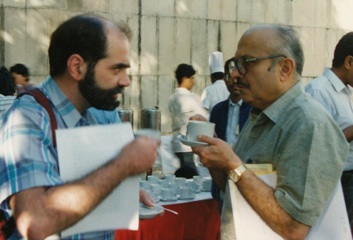
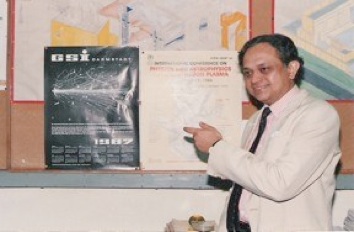
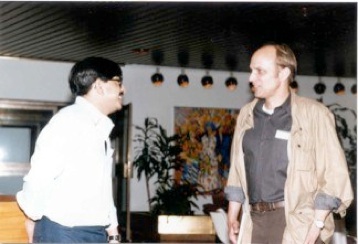
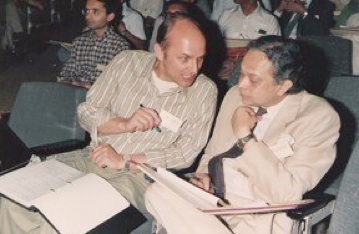
Top Left: Me and Gourang Yodh in Mumbai Top Right: Bikash Sinha at the first ICPAQGP in Mumbai
Bottom Left: Rajiv Gavai and Helmut Satz in Bielefeld Bottom Right: Helmut Satz and Bikash Sinha at ICPAQGP in Jaipur
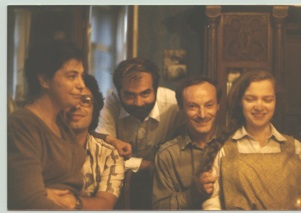
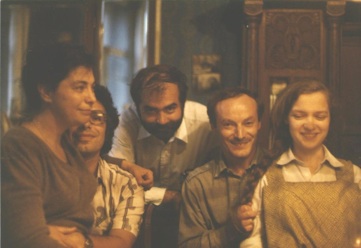
Professor at University of Minnesota: 1988-2000
Director of Theoretical Physics Institute 1989-1992
Member of Theoretical Physics Institute 1989-2000
Before moving to Minnesota, Alice and I made a visit to Minneapolis to find a house to buy. After a search of several days, we found a house suited to our needs. Alice wanted to be in the city close to shops, and public transportation. We also liked old houses with a lot of woodwork. The house we chose was in the Uptown neighborhood of Minneapolis, and built a little before the turn of the century. It had three stories including a basement, and was partially restored by folks who wanted to make fast money buying and reselling property. The restoration was worse than superficial. Cosmetically the house looked very nice. However in the basement was a furnace which did not register on any efficiency scale. If we had successfully turned on the furnace, the radiator system would have exploded since during the restoration, the expansion tank had been removed and not replaced. In addition, when it rained, water literally poured into the basement. The house also had a large garage that listed at a worrisome angle. There was a small room on the second floor that was beginning to sink; it had been built atop a back porch without a foundation. Of course, these things and others were fixable, and upon moving in we began a program of repair and restoration. One of the first things we needed to do was to get doors. There were no doors on the bathrooms nor for most of the rooms in the house.
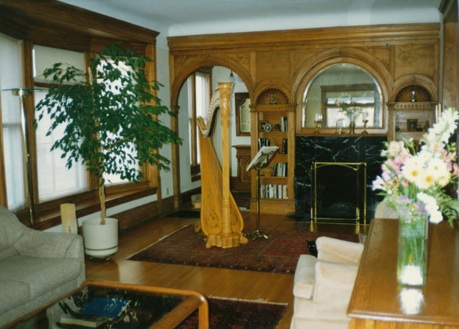
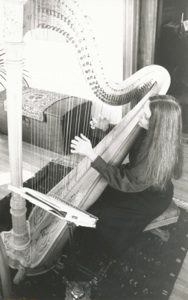
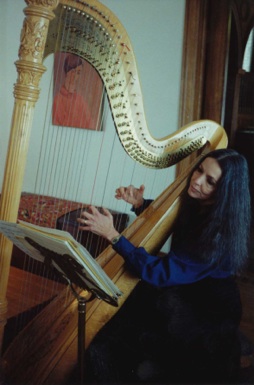
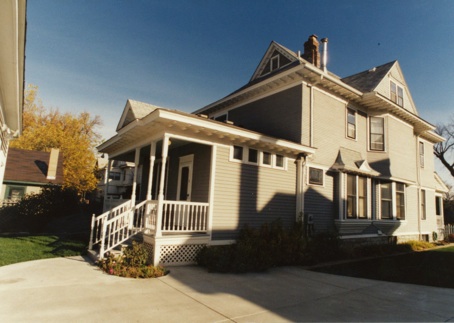
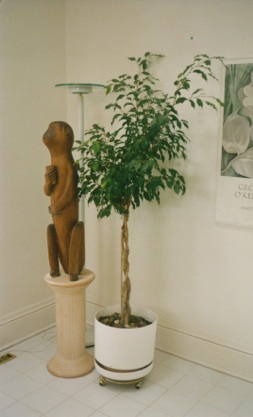
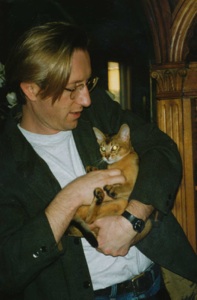
Shortly after moving to Minnesota, we had a visitor, Misha Shaposhnikov. Misha was an old friend from the Institute for Nuclear Research in Moscow, and had done seminal work on electroweak baryogenesis. Alice and I took him out to dinner in the Uptown area. Upon returning home, I discovered the front door was unlocked. Upon walking into the house, I found our oriental carpets all tied up and halfway down the stairs. We had apparently walked into a robbery in progress. While we were coming in the front door, the thieves had exited the back. They got nothing, but it prompted us to get our first alarm system. I always suspected the folks hired to unload the van that had transported our goods to Minnesota had spotted the rugs, and returned to collect them.
In the last few months of my time at Fermilab, I had been awarded a Humboldt Prize. This is an award from the Alexander von Humboldt Society in Germany which would pay for my salary for visits to German totaling twelve months. My award had been orchestrated by Walter Greiner at the University of Frankfurt. You can read about Walter in the anecdotes section. The Humboldt Prize had been given while I was still in Fermilab, and it would have been easy to take a year off to visit Frankfurt if I had remained there. Having just moved to Minnesota, I instead used it for shorter visits, which included several to Frankfurt for extended periods of time. These Humboldt visits marked the beginning of a long relationship with Walter Greiner’s group, and cemented a warm friendship with Walter.
The physics department at the University of Minnesota had recently received money to set up a Theoretical Physics Institute. Bill Fine, a local developer, had donated $2 million to the University, which was matched for the endowment of two chaired professors. In addition, the university was contributing about $1 million per year for operating the TPI. Steve Gasiorowicz, Marvin Marshak, Alan Goldman and Chuck Campbell had been essential in negotiating the resources and setting the TPI in motion.
When I first came there, the money was basically in place, and Steve Gasiorowicz, who was acting director, had run a number of workshops on topical issues. Shortly after coming to the University, I was made acting associate director, and a little while later acting director, director and the first member of the TPI.
An important part was trying to hire faculty for the TPI. This was complicated since there were competing visions of the institute, and of the areas of physics it should cover. Steve had tried to hire distinguished scientists from within the US without success. It was clear that if one could hire outstanding people, the people one hired would determine the areas of interest.
I understood from my trips to Russia that the Soviet Union was disintegrating. If this happened, there would be a mass exodus of talented physicists from Russia. There might be a variety of possibilities of arranging joint appointments with Russian institutions, or directly hiring Russians who had decided to leave Russia. In any case, the first thing I did as acting director was to arrange for visits of a year for half a dozen Russian scientists and their families. I was told that if I invited two people from an institute, this would improve the chances of being allowed to leave for the visit. For a year’s visit, I could also have their families come with them. I invited Arkady Vainshtein and Iosif Khriplovich from Novosibirsk, Misha Volsohin and Yuri Semenov from the Institute for Theoretical and Experimental Physics in Moscow, and George Savvidy and Alex Khodjamarian from the Yerevan Physical Institute in Aremenia. They all accepted and they all came.
Bill Fine had recently built a high rise in downtown Minneapolis, 110 Grant, that was only partially occupied. This provided an opportunity to put the Russian community into excellent housing, close to public transportation, in a little community where they could help one another out. We also put longer term visitors there.
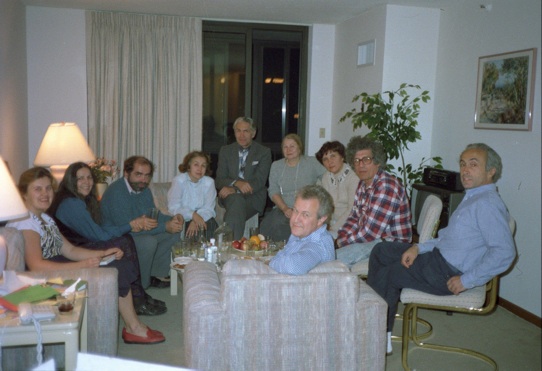
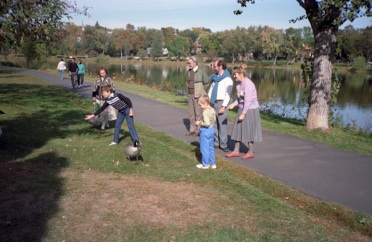
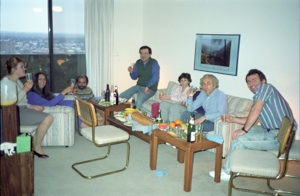
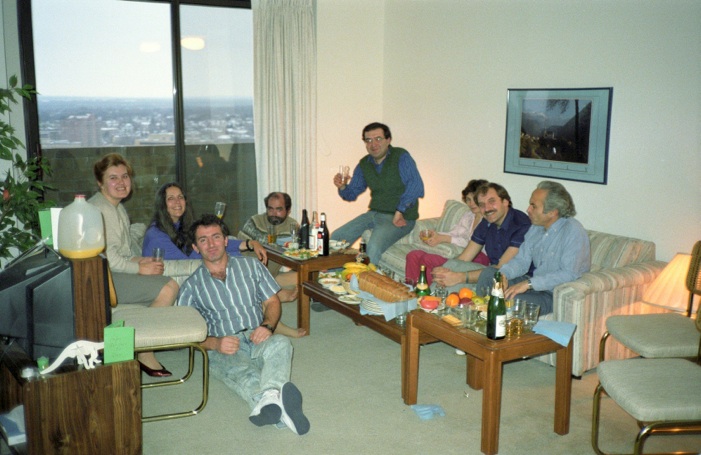
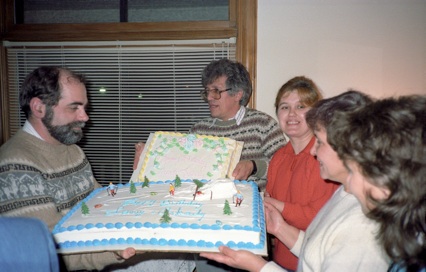
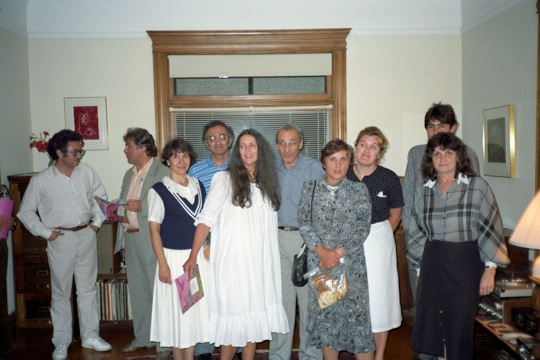
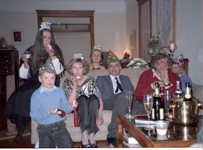
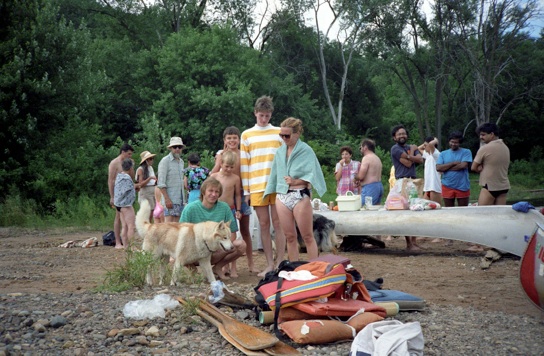
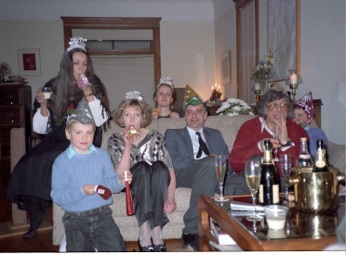
Top: Natasha Volshina, Alice, Me, Yuri Semenov and wife, Alyesha Anselm (forward) and wife, Nellie and Arkady Vainshtein, and Iosif Khriplovich
Middle: A get together at our home. Boris Shklovskii is to the left behind Alice and Volodya Gribov is to the right. Julia, Voldya’s wife is on the far right.
Bottom: Natasha Volshina, Alice, George Savvidy, me, Alex Khodjamarian, Sergei Voloshin and wife and Iosif Khriplovich
The first Russians I got for long term visitors were particle physicists. After about a year, I also invited condensed matter theorists Boris Shklovskii and Leonya Glazman to visit us. At the end of the first year, we made offers to Arkady Vianshtein, Misha Voloshin, Misha Shifman, Boris Shklovskii and Leonya Glazman. There were a variety of different way that people arranged their appointments with their institutions in Russia.
I had excellent relations with the visiting Russians and those who ultimately remained at Minnesota. We had many parties together; we would go together canoeing or cross country skiing. On one of these expeditions, I discovered that Nellie Vainshtein called Arkady Arkadinka, and sometimes Arkaka. This led to me calling Arkady “Milaya Arkdinka” which roughly translated means “My Dear Sweet Little Arkady,” although using the wrong gender for the adjective. Arkady did not like this, but he had his ways of getting revenge. Arkady and I also had birthdays on the same date, and would have joint birthday parties. Photos from some of these are shown in the Alice section.
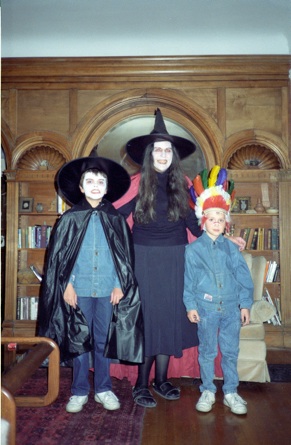
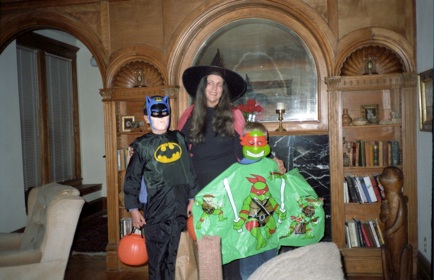
Upper Left: A day in the park with the Volshins and the Semenovs
Upper Right: The Volshins, Vainshteins and Novikovs on New Years Eve
Left: The annual canoe trip. In the background in blue is a young Raju Venugopalan with a full head of hair
Above: Alice and the Mishenka and Alyesha Voloshin preparing for two successive Halloweens
Right: Me, Arkady, Natasha Volshina, Nellie Vainshtein and her daughter celebrating a joint birthday for Arkady and me.
My best friend in Minnesota is Misha Voloshin. Misha is a brash and brilliant theoretical physicist. When you ask him a question, his response is “How can you possibly ask such a stupid question? Every graduate student in Moscow knows that....” One of the essential items which the Russians needed to learn in Minnesota was to drive. Misha got a learners permit and a car. At night, his children would go out in sit in the car, pretending to drive in anticipation of Misha’s receiving his license. I took him to his first exam, and he failed the driving part of it. This was a total disaster for Misha, who I think had never gotten a score less than A+ on any exam he ever took. I then began going out with Misha every night for about two weeks, where we drove around corners, parallel parked, and backed up endlessly. It was a good time of male bonding. I was cruel however to Nataha, Misha’s wife, who was I think a little disappointed when Misha failed his first test. On returning back after Misha had passed and received his license, I lied and told her that Misha had failed and that he was told not to come back for a year. I did not torture her for more than a few seconds, and I think she has never forgiven me.
George Savvidy is a person of great joy with a true love of life. He loves to tell jokes, but while at Minnesota, his English was not so good. When he told a joke and got to the punch line, people would stare with blank faces trying to understand his point. One day at lunch he began telling jokes to a Japanese visitor, who had minimal English skills. When George told a joke, the visitor sensed the punch line, and would politely laugh. George would then tell another joke, getting more excited since he finally found someone who appreciated a good joke. This went on for several hours. After this, he and the young Japanese visitor become very good friends.
With the Russians at Minnesota, it was a very good place for me to do physics. I became involved in a project to understand high energy scattering in electroweak theory. We followed a conjecture by Andreas Ringwald that non-perturbative processes in electroweak theory might make events where large numbers of the very heavy particles associated with electroweak theory might be produced. These events would be spectacular, and naively, it appeared they occurred with a high rate. After several years of work from our group at Minnesota, Andreas Ringwald in DESY, Al Mueller at Columbia University and Valery Rubakov’s group in Moscow, it was established that the rates for such processes are very small. This led to some understanding of non-perturbative processes in field theory, but the end result was disappointing.
I had been working on problems related to electroweak baryogenesis before leaving Fermilab. I continued this with Misha Voloshin and Misha Shaposhnikov who was visiting Minnesota. We developed a mechanism which might lead to large enough amount of baryon number to explain the matter asymmetry observed in cosmology. This turns out to be one of many possible mechanisms which were subsequently developed.
I think the most important thing I learned from my Russian colleagues was that if you have a good idea in physics, you should carry it to completion, even if it takes many years. My philosophy prior to coming to Minnesota was to work in an area for a few years, and then move into another set of problems. My Russian friends convinced me by example that one has to have real conviction about the problems that you consider to be important, and such conviction implies a commitment to see a problem through to completion. They also showed me that one should never be frightened to attack big problems which appear to be hard to solve. Most important is trying one idea, and then another, and then another until the problem yields.
I also became very good friends with a widening set of Russian colleagues. Vadim Kuzmin, of the Institute for Nuclear Research was the intellectual and spiritual father of the theory group at the Institute for Nuclear Research in Moscow, is shown below. He was the mentor of Valery Rubakov and of Misha Shaposhnikov. Vadim visited for extended periods of time, and while there made some beautiful paintings, one of which now hangs in my office at home. I visited this group many times and attended the Quarks meeting run by his group.
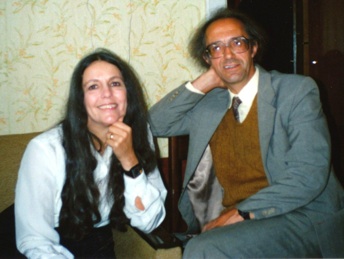
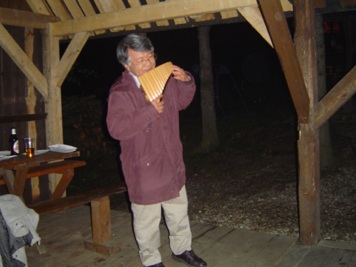
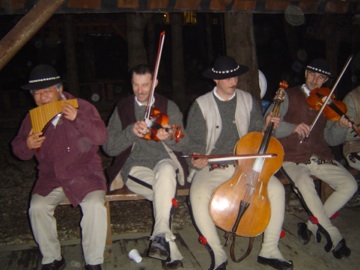
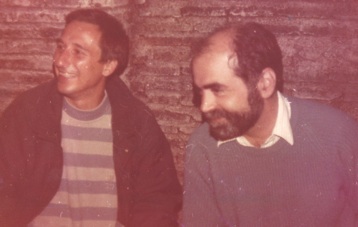
Left: Alice with Vadim Kuzmin in Moscow
Right: Andreas Ringwald and me in Telavi Georgia
A picture of me with Andreas Ringwald shown in the picture above on the right was taken at a meeting in Telavi, Georgia. The meeting was a very interesting one. The issue of whether or not one produced spectacular events in high energy collisions of weakly interacting particles was hotly contested, and almost everyone working on the problems was there. In the night, after the regular meeting, we would sometimes hold discussions in the cellar of the hotel. There would be much Georgian wine and Scotch Whiskey. The discussion would sometimes be very agitated, but all done in good spirit.
Often very late at night, I would gather together with my good friends Sasha Dolgov, Iosif Khriplovich, Victor Novikov and Andrei Smilga, and a young British physicist, Caroline Frasier, and we would drink Georgian wine and Armenian cognac talking of things political, scientific, and cultural. I think the Russian guys were trying to get Caroline drunk, but they were never successful. They however were less than sober by the end of the evening. The last night of the meeting, we had a particularly long discussion. It ended with Andrei Smilga deciding he wanted to go mountain climbing, so in the middle of the night he left the hotel walking in the general direction of the mountains. These mountains are about 100 kilometers distant from Telavi. By morning, he found himself in someone’s orchard on the edge of the city, being challenged by a man with a gun. Andrei got upset by this and reported the guy to the police. They all went to the station and Andrei was strongly encouraged not to make charges as doing so would result in both parties being put in jail. So Andrei gave up, but by that time everyone had left for their planes and trains. Andrei was stuck in Telavi with little money, and a ticket for a flight in Tiblisi which he could not get to on time.
Meanwhile, there had been a train crash in Georgia, and all train traffic was canceled. On my flight leaving Tiblisi there was literally standing room only, and I remember a young German colleague praying as a dangerously overloaded plane left the ground barely gaining enough speed to make it off the runway.
Andrei somehow had or got enough money so that he could call his wife and ask her to help, but by that time his friends were back in Moscow. She had found out what had happened, and would send him no money. I still do not know how he ever got out of Tiblisi.
Caroline Frasier was a promising young theoretical physicist. A few years after this meeting,
she took a trip to Africa. Upon returning to Britain, she fell sick. She went to the public health service
complaining of being very ill, but neglected to mention she had recently returned from Africa and had prematurely stopped taking her malaria medication. The nurse she saw, not being fully informed of the circumstances, recommended aspirin and rest. By the next morning she was dead.
One of the very good friendships I made in Russia was with Valery Rubakov. Valery developed many
of the ideas associated with electroweak baryogenesis. I have shared many hours with him climbing on trails in the Colorado Rockies in search of wild mountain trout. Valery is a one of the top theoretical physicists I have met, but he is even more impressive as a human being. He deeply cared about the young people in Russian science. He has consistently refused offers in the West on the grounds that someone needs to remain in Russia to educate the young. He is painfully honest both in science and personal relations. He will not spare your feelings by telling you a lot of diplomatically phrased half-truths. His friends respect and love him for this simple honesty.
During the time I was in Minnesota, I kept my ties with China. I visited China early after the unfortunate events in Beijing in 1989, for I did not want my Chinese friends to become isolated. As I said above, I think boycotts oftentimes damage those whose support one most needs in order to affect change.
My goal was to make arrangements so that my Chinese friends could also visit us at the Theoretical Physics Institute in Minnesota. I kept the visit very low key, and met only with scientists. I made no visits to touristic spots, nor did I attend banquets with local officials.
As a result of this visit, I succeeded in arranging for a number of Chinese visitors to Minnesota, including my old office-mate at SLAC, Chong-shou Gao. Gao remains a good friend. Life has changed much in China for academics. On my first visit, their apartments were very small, around 15-20 square meters. Now a professor at Peking University might have a 100 square meter apartment near the university in downtown Beijing. The apartments available to scientists will have modern conveniences, and there is no feeling that people are frightened of their government. For a young Chinese scientist of talent, it is now very attractive to return to China.
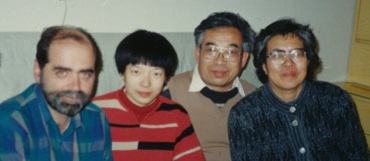
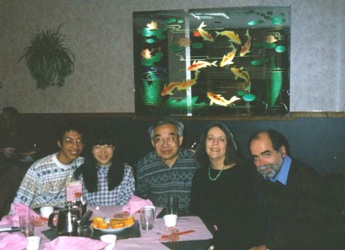
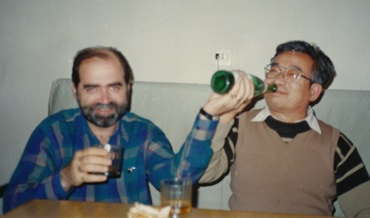
Left: A visit with the Gao’s shortly after the time of Tianamin Square
Above: Gao, his daughter and her husband in Minneapolis
I also helped Gao to arrange for his daughter to enter into the physics graduate school at the University of Minnesota. She married a fellow Chinese graduate student there, and remains in the US.
Towards the end of my stay in Fermilab, a colleague of mine at Fermilab, Gaston Gutierrez arranged for me to visit both Brazil and Argentina. Gaston was at that time married to Sylvia, and they lived a few blocks away from us in Fermilab. Sylvia and her family had been horribly caught up in the violence of the military dictatorship of Argentina. She had been taken for an interview with the secret police, and somehow survived. Friends and a member of her family were not so lucky. By the time I knew her, Argentina had settled down and the dictators were gone.
I remember staying in Buenos Aires in a hotel where they changed the rates every few days. Inflation was very high, and they needed to change the rates so they could keep them at par. I met some of the physicists at the cyclotron lab, but physics was at that time still in disarray. Many of the most famous Argentinan physicists had lost their jobs during the time of the military. Given the academic predisposition to left wing politics and the dictator’s bloodlust, they were quite lucky to have survived.
It rained the entire week I was in Buenos Aires. Water flooded my office at the cyclotron lab. When I left by taxi for the airport, we had to take many detours. At the bottom of hills, there were often flooded streams, and cars which had not quite made their way through them.
I arrived in Rio de Janeiro for a conference. Carlos Aragao was the principle organizer. I knew Carlos from a meeting in Bielefeld years before. Carlos is a charming man, and when we would go out to the Ambassador Club, the ladies at the club wanted to take him home and provide him a private cabaret. He has now become important in science politics in Brazil, after a successful career as a theoretical physicist and an academic administrator. Carlos is one of those people with natural people skills.
At the meeting in Rio, I met my very good friend Yogiro Hama. Yogiro was born in Brazil in 1936. As a 4 year old boy, he was visiting Japan with family, and war broke out. He remained in Japan until
after the war, and his family could afford to have him return home. He started physics studies in Brazil, but returned to Japan to do his PhD in Yukawa’s group in Kyoto. He eventually returned to Brazil where he became a Professor at the University of Sao Paolo. His is presented in the wonderful biographical sketch by Takeshi Kodama, who I describe below.
Yogiro and I liked one another immediately. Yogiro loves simple things in life. Good fresh fruit from a market, an inexpensive but good bottle of wine, and the company of friends and colleagues. He introduced me to uniquely Brazilian drinks and foods.
This first meeting I attended was organized by Erasmo Ferreiro. He is the initiator of the study of hadronic physics in Brazil. He is a very kind man, and the formation of a strong community owes much to his personal charisma. He is referred to as “General” by Takeshi.
I was entranced by Brazil. I stayed in an inexpensive hotel on Copa Cabana. I learned that you were safe so long as you left all jewelry, credit cards, and all but a little cash in the safe in your room. I wore a t-shirt and a bathing suit everywhere. I remember on one of my visits to Brazil, a young Japanese man who on the first day of the meeting had a fancy camera strapped around his neck. He also took the bus to the meeting. The second day of the meeting he had no camera for the obvious reason. I took the taxi when I wanted to go somewhere.
I made many visits to Brazil over the years. Later I started going to the meeting Relativistic Aspects of Nuclear Physics, run by Yogiro and Takeshi Kodama. Takeshi became another very good friend.
Takeshi was born in Japan. He married an Italian woman, and his children are thoroughly Brazilan,
which is even truer of the next generation. Brazil truly is a melting pot of culture and races. I think this is why I love it so much.
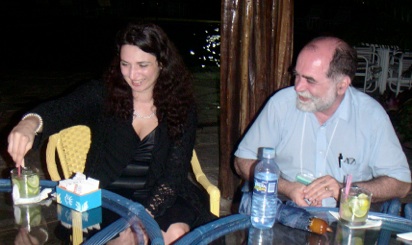
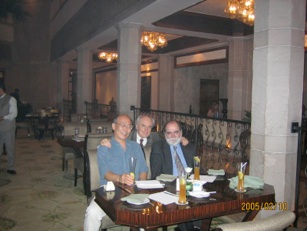
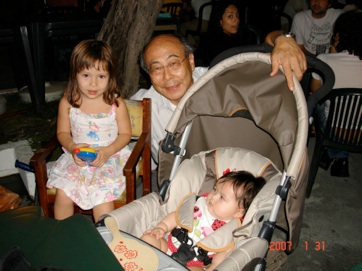
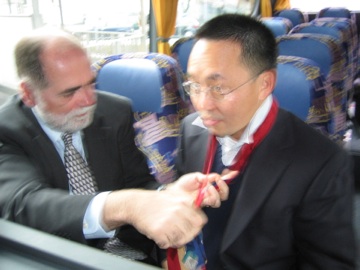
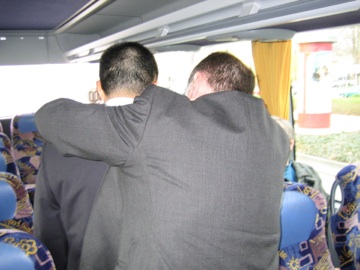
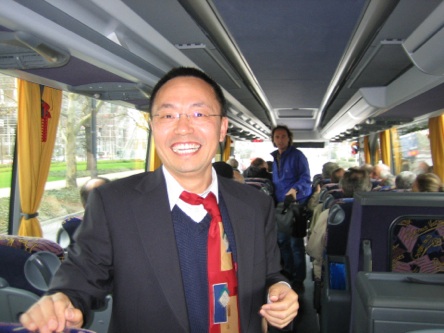
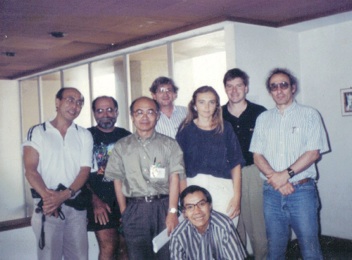
Upper Left: Takeshi Kodama, me, Yogiro Hama, Johann Rafelski, K. C. Chung, Gradzhina Odyniec, Wolfgang Bauer and Gordon Baym at an early Relativistic Aspects of Nuclear Physics
Lower Left: Me and Sonya Kabana at a RANp meeting
Upper Right: Takeshi Kodma and his grandchildren
Lower Right: Tekshi Kodama, Jean Paul Blaizot and me in Calcutta
Takeshi Kodama and Yoghiro are the godfathers of relativistic nuclear physics in Brazil. This and the QCD community in Brazil has grown enormously during 20 years I have been visiting. The younger generation includes people such as Sandra Padula, Frederique Grassi, and Eduardo Fraga who will be
among the leaders of this community in future years. Takeshi and Yogiro started the Relativistic Aspects of Nuclear Physics meeting, from which I recently returned. This is an international meeting
which has become very exciting with excellent attendance by the young scientists of Brazil.
During Walter Geriner’s 70’th birthday celebration in Frankfurt, I had an opportunity to teach my good friend Nu Xu, now spokesperson of the STAR experiment, how to tie a tie. Takeshi caught it on camera. (Nu is a regular visitor to Brazil and a friend of both me and Takeshi.) Please note the look of delight in Nu’s eyes once I showed him how it should be done.
Teaching Nu Xu how to tie a tie.
(As a spokesperson for STAR, he really needs to know these things)
In 2006, I went to Brazil to attend the International Conference on Nucleus-Nucleus Collisions in Rio de Janeiro, and the International Symposium on Multiparticle Dynamics in Paraty. Paraty is a very scenic and historical town on the coast of Brazil between Rio and Sao Paolo. It is an old colonial city. It had a unique sewer system. The tides are very regular there and for a few days each month they are at their highest point. The city was arranged so that the gutters would fill with water during these incoming high tides, and when the tide receded so would the sewage. When the tide is in, it is best to walk barefoot.
The town is picturesque and filled with hotels of interesting architecture.
I was asked by Takeshi and Yogiro to do the conference summary. This is a hard job, since I had to carefully follow each talk, get copies of the presentations, and electronically join them together, and try to make a coherent picture of the meeting. I take such jobs seriously, largely because many young people give talks, and they deserve recognition for their accomplishments. Needless to say, the night before the talk, I got little sleep. I was up until 4 in the morning, which turned out to be OK because there was a fiesta going on with loud music and fireworks. It ended around 3 in the morning and when I finally got in bed, I fell asleep. In a short time fireworks went off, there was the sound of the church bells ringing, and the local priest went from door to door past all the hotels with a choir singing. The church borders on the piazza where the fiesta was held, and I fear he too was awake all night, and this was his reward for the tourists who had partied all night.
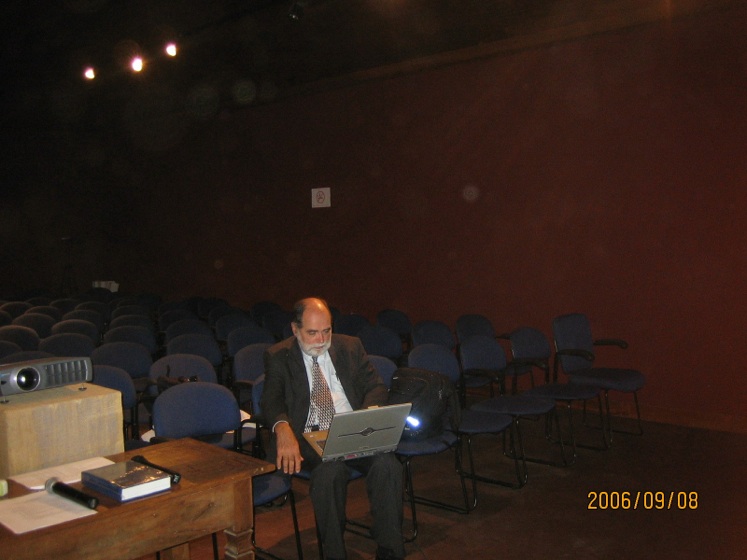
Preparing for the summary talk in Paraty. I rarely wear a suit in Brazil.
Brazil is a wonderful place to meet colleagues from around the world. I regularly have met colleagues from France, Germany, Italy, and India. Below are some photos taken from a meeting in 2004, which was held in an eco-hotel on the coast between Rio and Sao Paolo. The one on the left is Ulrich Heinz from Ohio State University, and Edmond Iancu from Paris. The one on the right is me and Jean Paul Blaizot from Paris. In the photo with Jean Paul, we are on the little boat which took us to a beach where we could swim in the morning. The photo on the left is at night during dinner. At night, the yard in front of the hotel would be full of very large rodents, the capybara. I show one below. They are real.
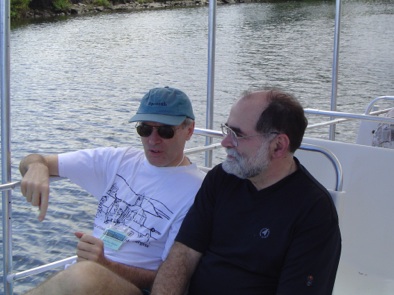
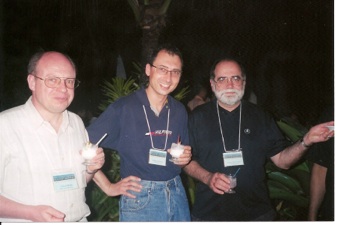
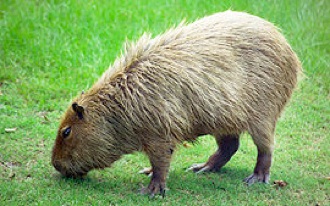
Upper left: Enjoying caipurinhas with Ulrich Heinz and Edmond Iancu.
Upper Right: Going to the beach with Jean Paul Blaizot
Left: A capybara
